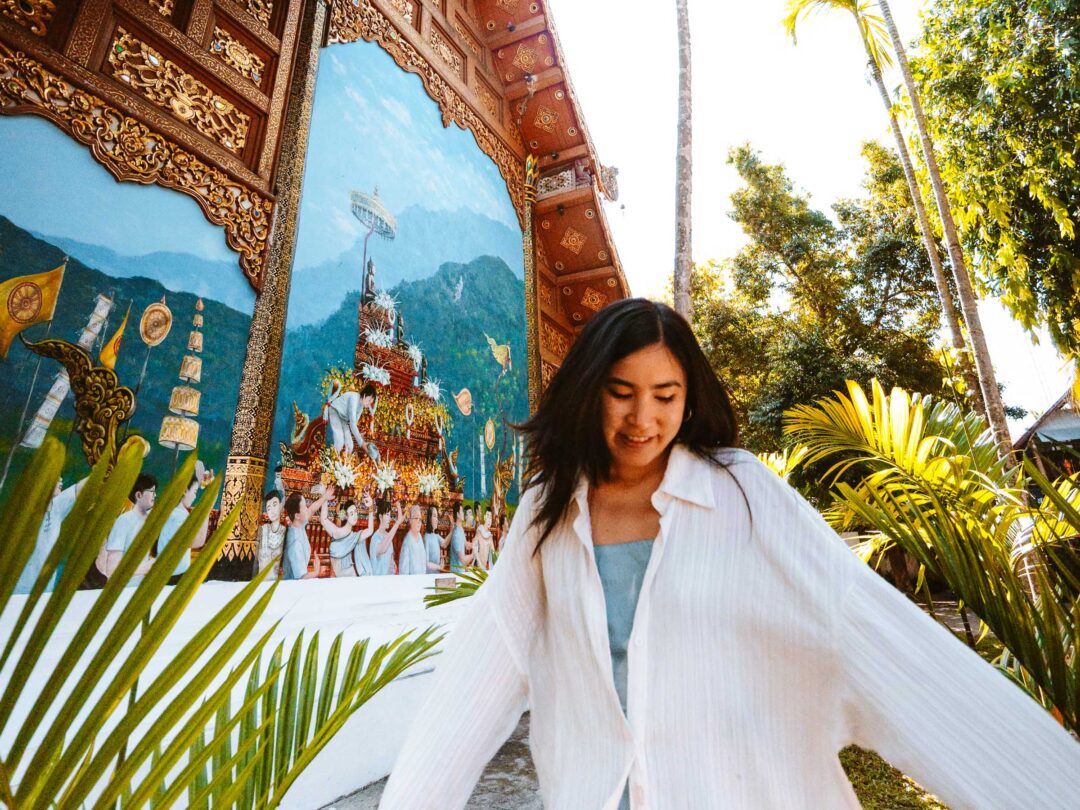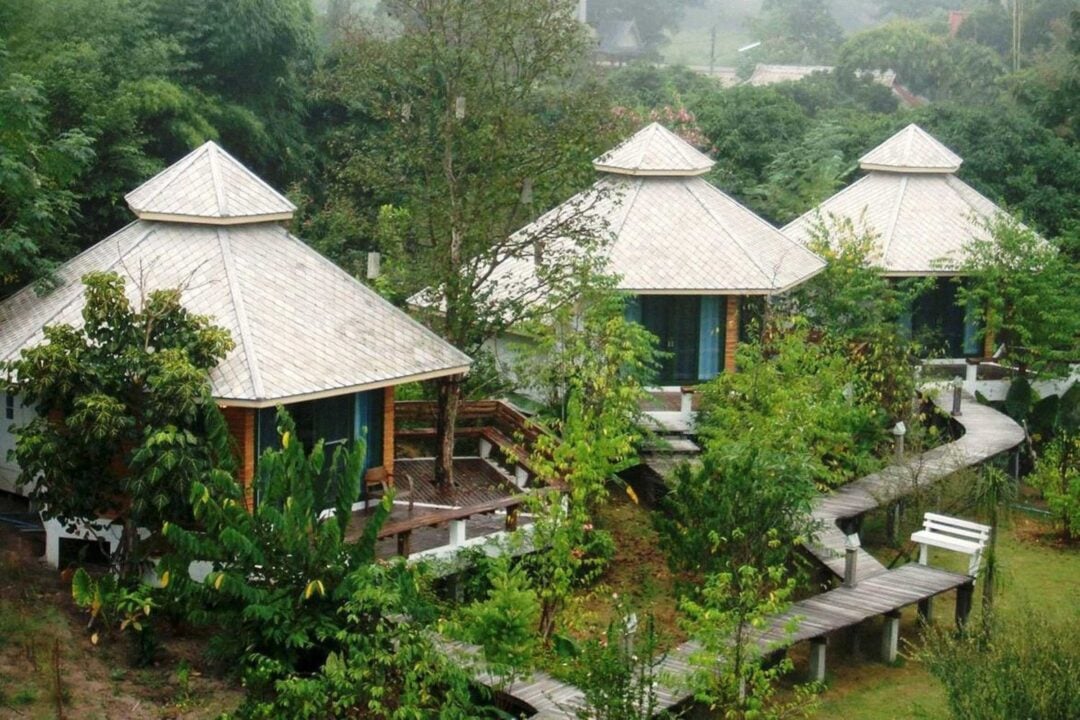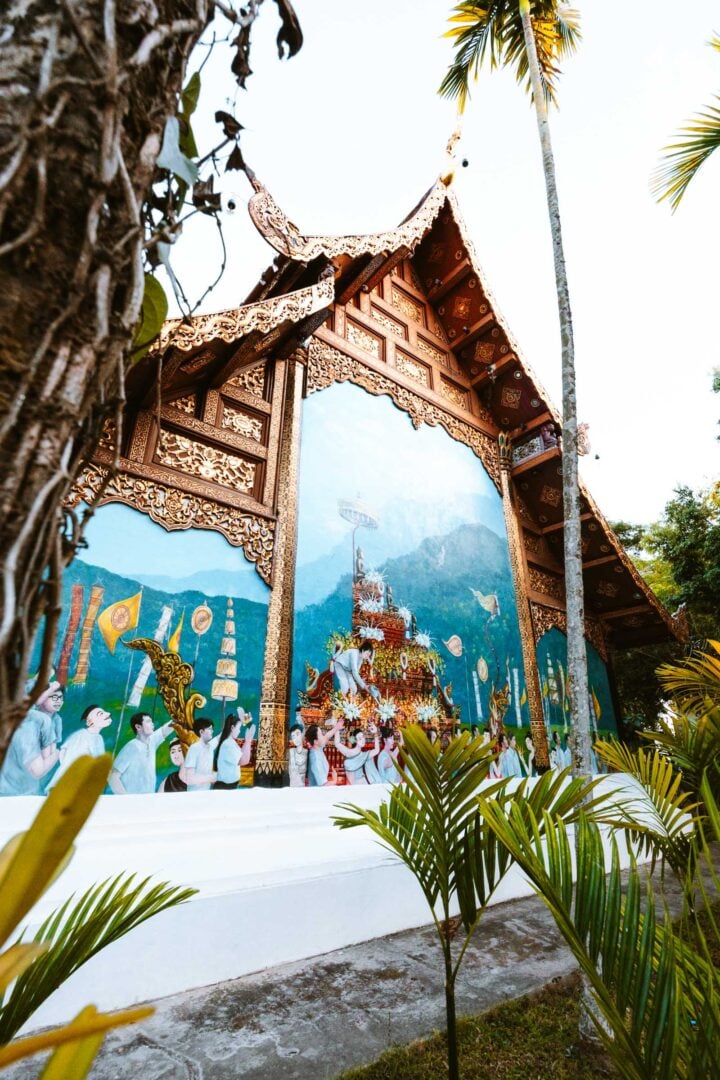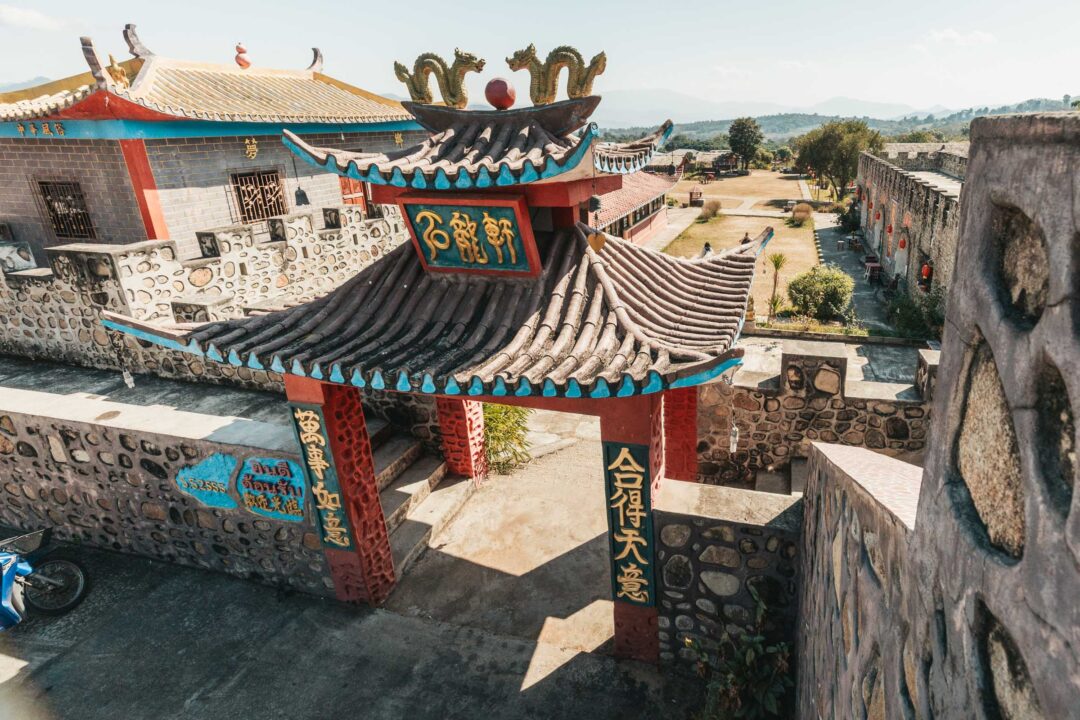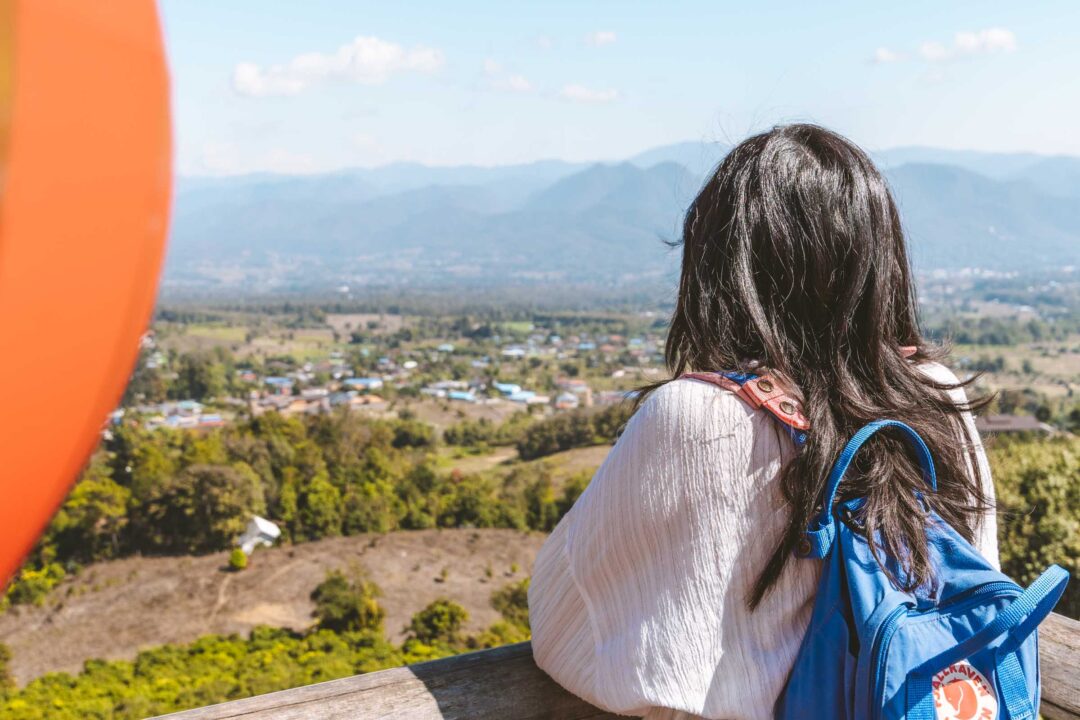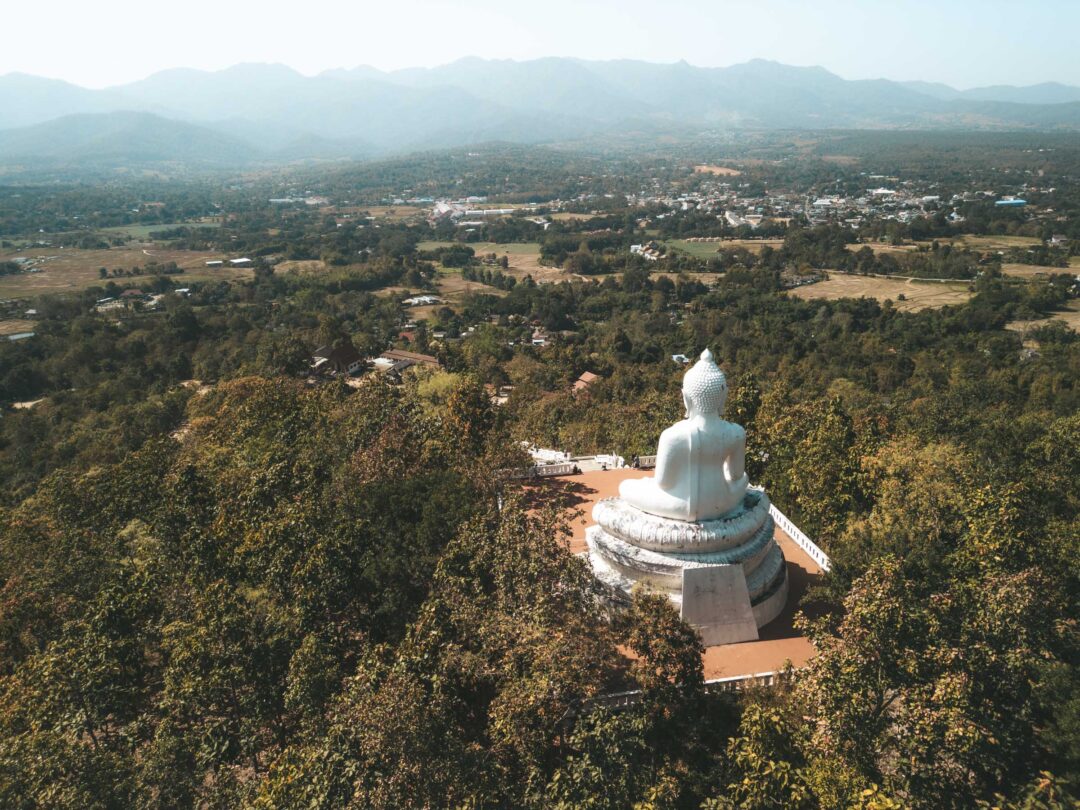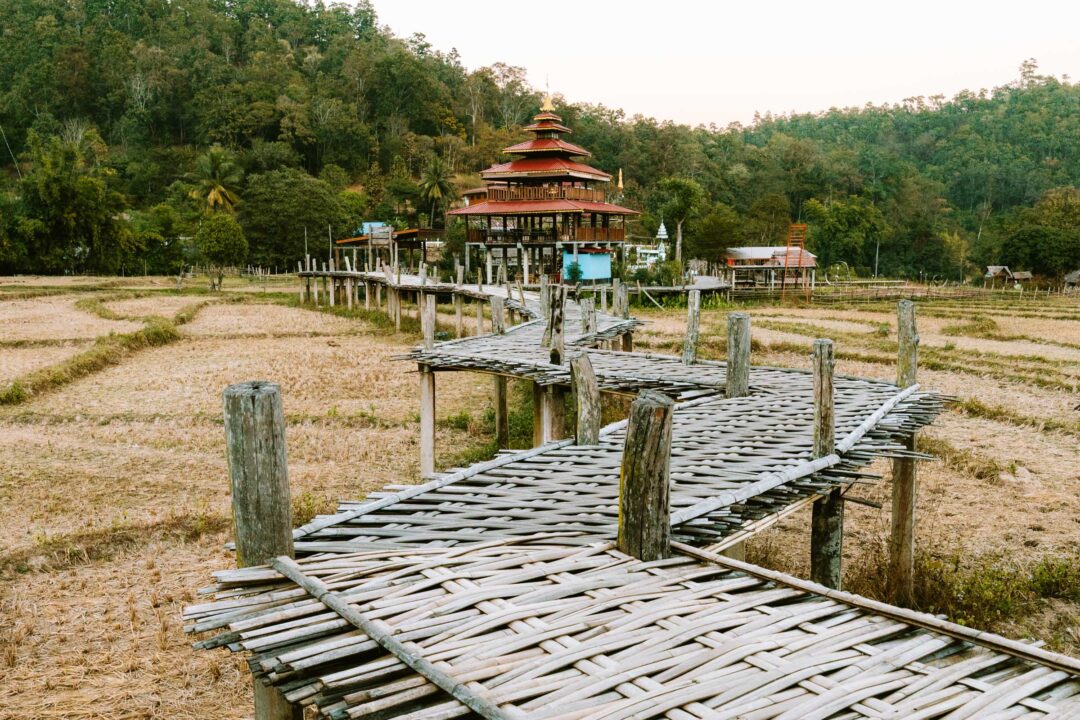When we first got to Pai, we had no idea that we would find so many things to do there. It has the perfect balance of nature, chill vibes, and history for it to be our favorite destination in Thailand.
But while Pai is famous as a backpacker hotspot, there’s so much more to explore there – no matter what type of traveler you are.
We spent 7 days in Pai, going to both its popular spots and lesser known attractions. In this guide, we’ll share all the best things to do in Pai to make your trip there unforgettable.
If you are based in Chiang Mai you can check out the top-rated Pai Highlights Private One Day Trip, which includes transportation and a guide.

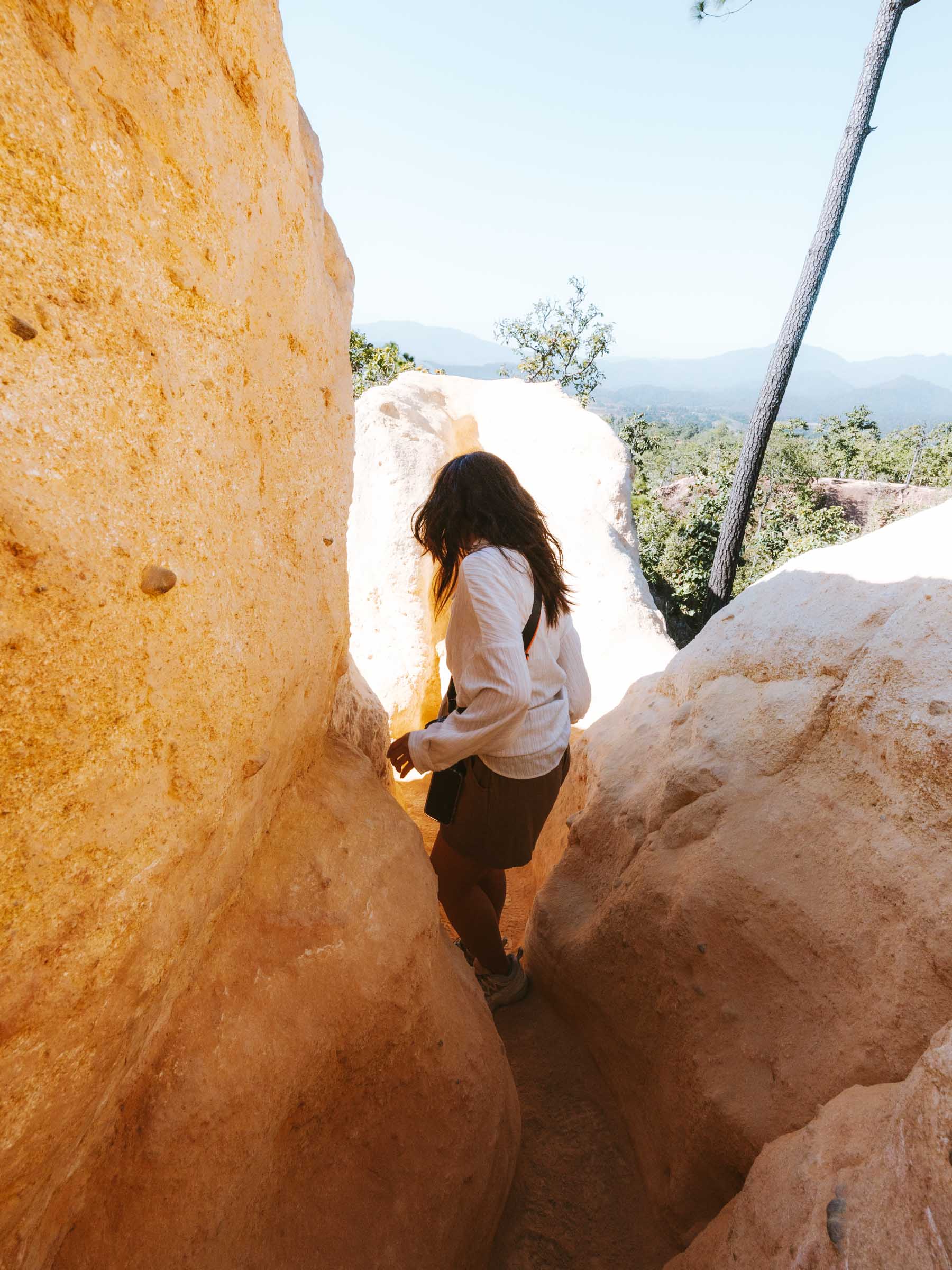
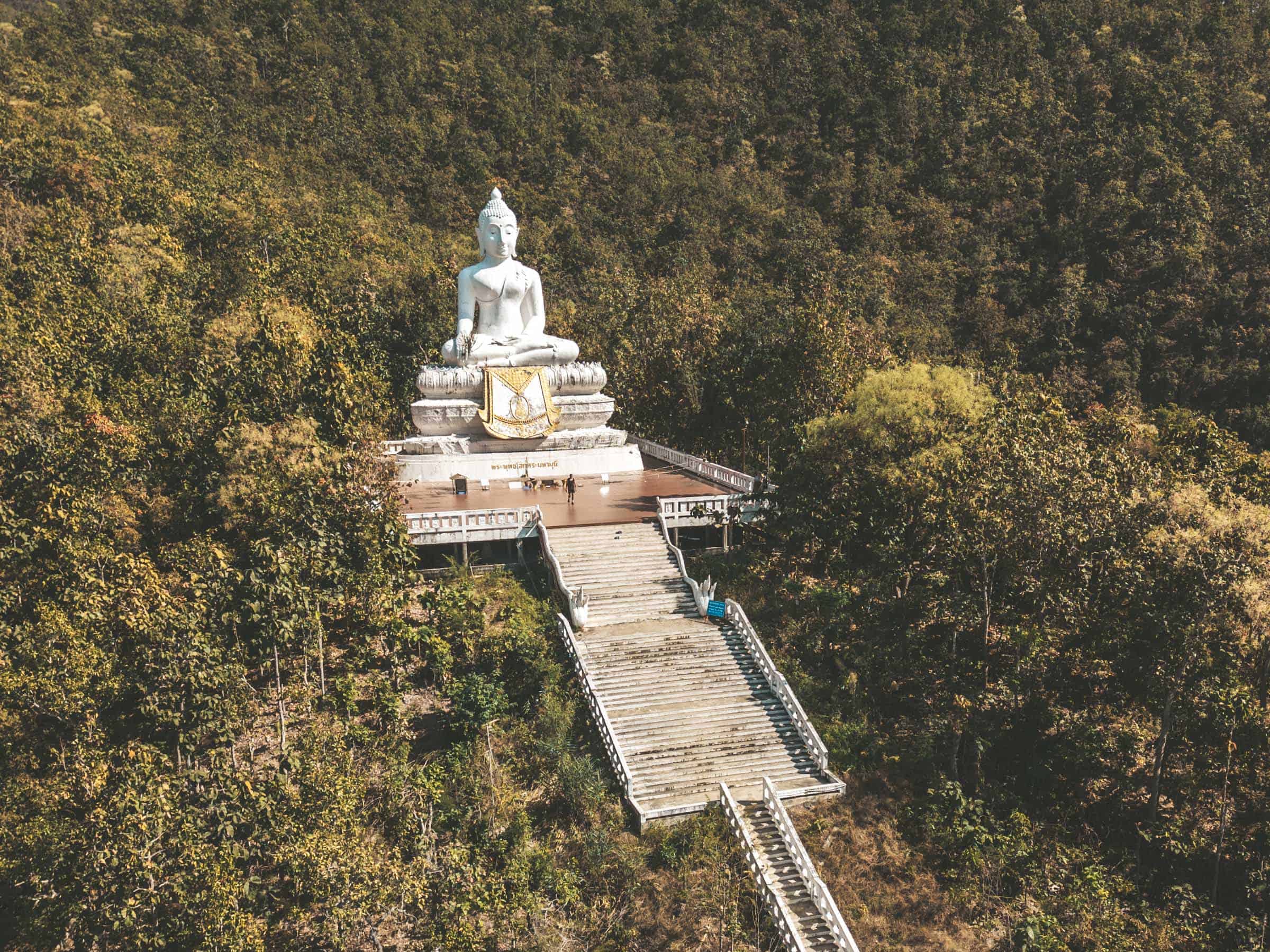
14 Incredible Things to Do in Pai
Pai Canyon
Pai Canyon has incredible panoramic views and is arguably the best place to enjoy the sunset in Pai. But beyond the sunset, Pai Canyon also has sweeping panoramic views and narrow ridgelines that you can explore.
The layout of Pai Canyon what makes it unique. Narrow ridges snake out in all directions.
But visiting Pai Canyon isn’t just a walk in the park. Its ridges have steep drop-offs on either side, so just navigating the place is an intense task that requires your full attention. In some places, the path is so tight that only one person can pass at a time.
If you’re not comfortable with heights, you can still enjoy the views at Pai Canyon without going into the steep areas.
Every evening, Pai Canyon turns into a social scene as people gather there to sit around and chat while watching the sun dip below the mountains. And best of all, there is no entrance fee to visit Pai Canyon.
Read our full blog post: Pai Canyon: Complete Guide
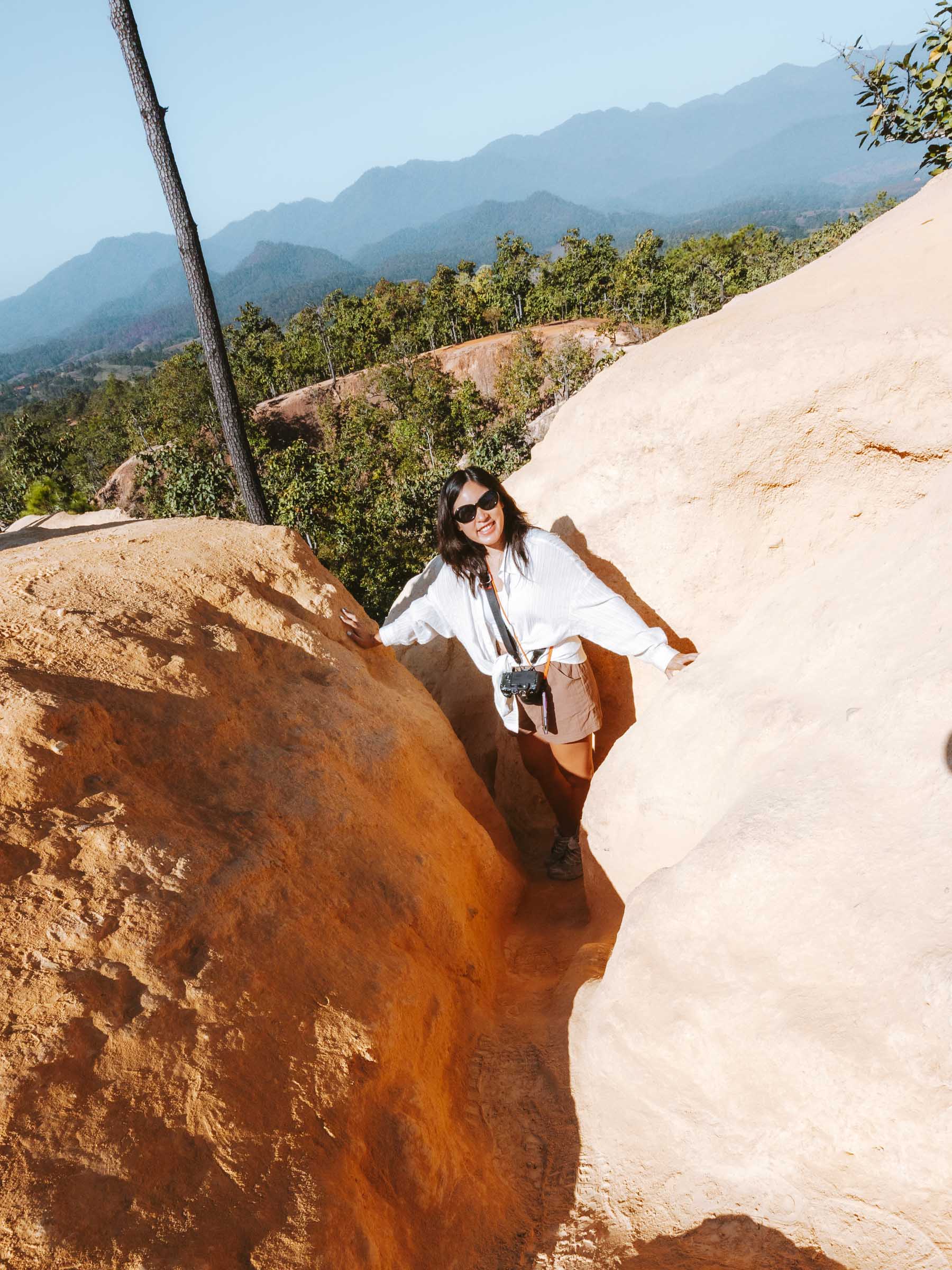
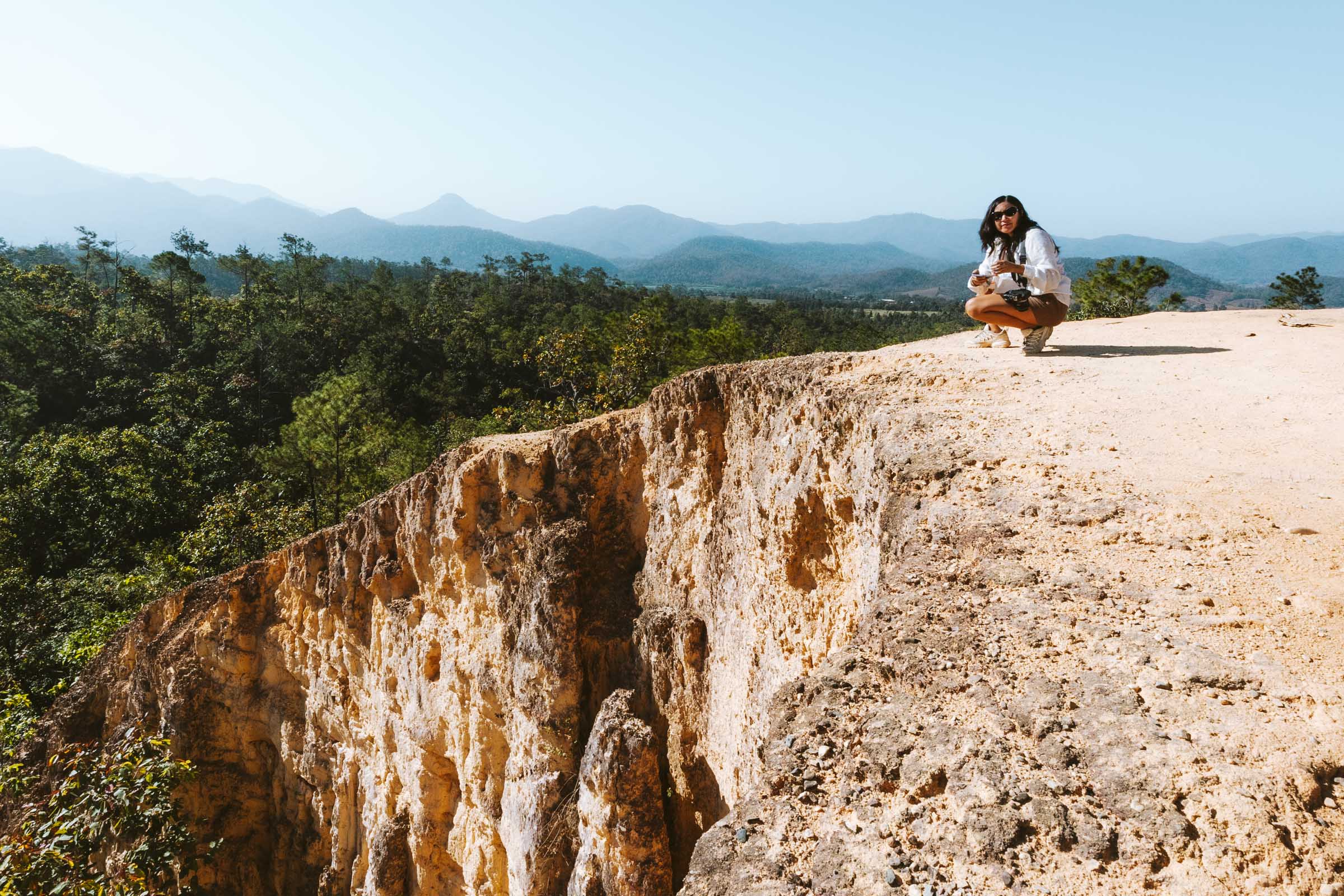
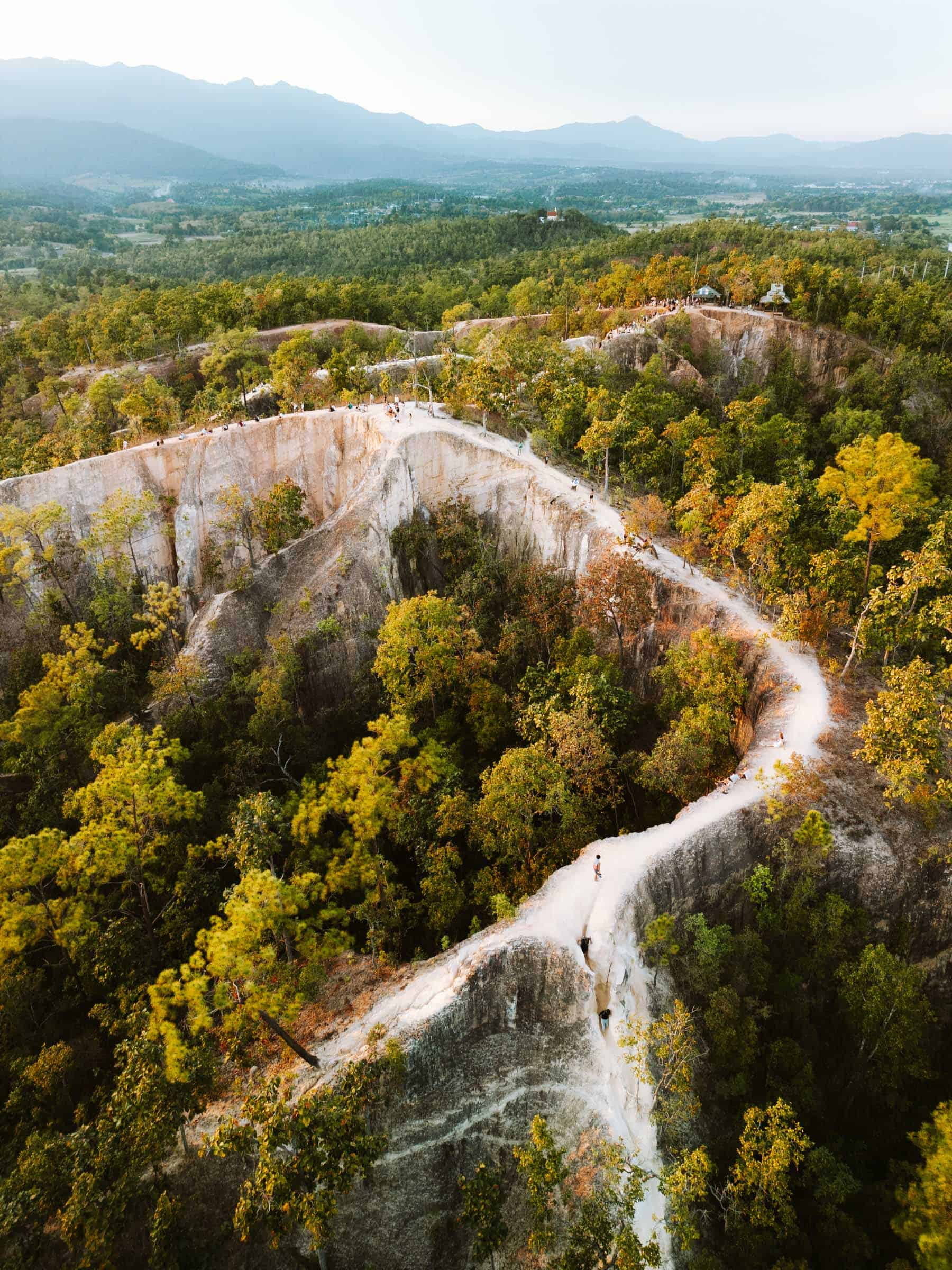
Sai Ngam Hot Spring
Sai Ngam Hot Spring ended up being the highlight of our trip to Pai. It’s tucked under a shady forest canopy in a nature reserve north of town, and going there feels like you’ve wandered into a hidden pocket of the jungle.
But what surprised us most about Sai Ngam was the water itself. It’s not scorching like some hot springs, but not cold either. It’s a perfect, in-between warmth that made us spend two hours there hanging out in each of its three tiers and chatting with a few others who were there to relax as well.
The hot spring is set underneath a forest canopy, where it flows out of the ground, and then cascades down 3 levels divided by embankments, creating different areas where you can relax.
The water temperature at Sai Ngam hovers around 25-30 degrees Celsius, a little warm and not too hot.
I recommend visiting Sai Ngam Hot Spring right when it opens at 8 AM. It was peaceful and quiet for us early in the morning, but by 10 AM, tour groups started to show up and the place began to get crowded.
Read our full blog post: Sai Ngam Hot Spring in Pai: Complete Guide

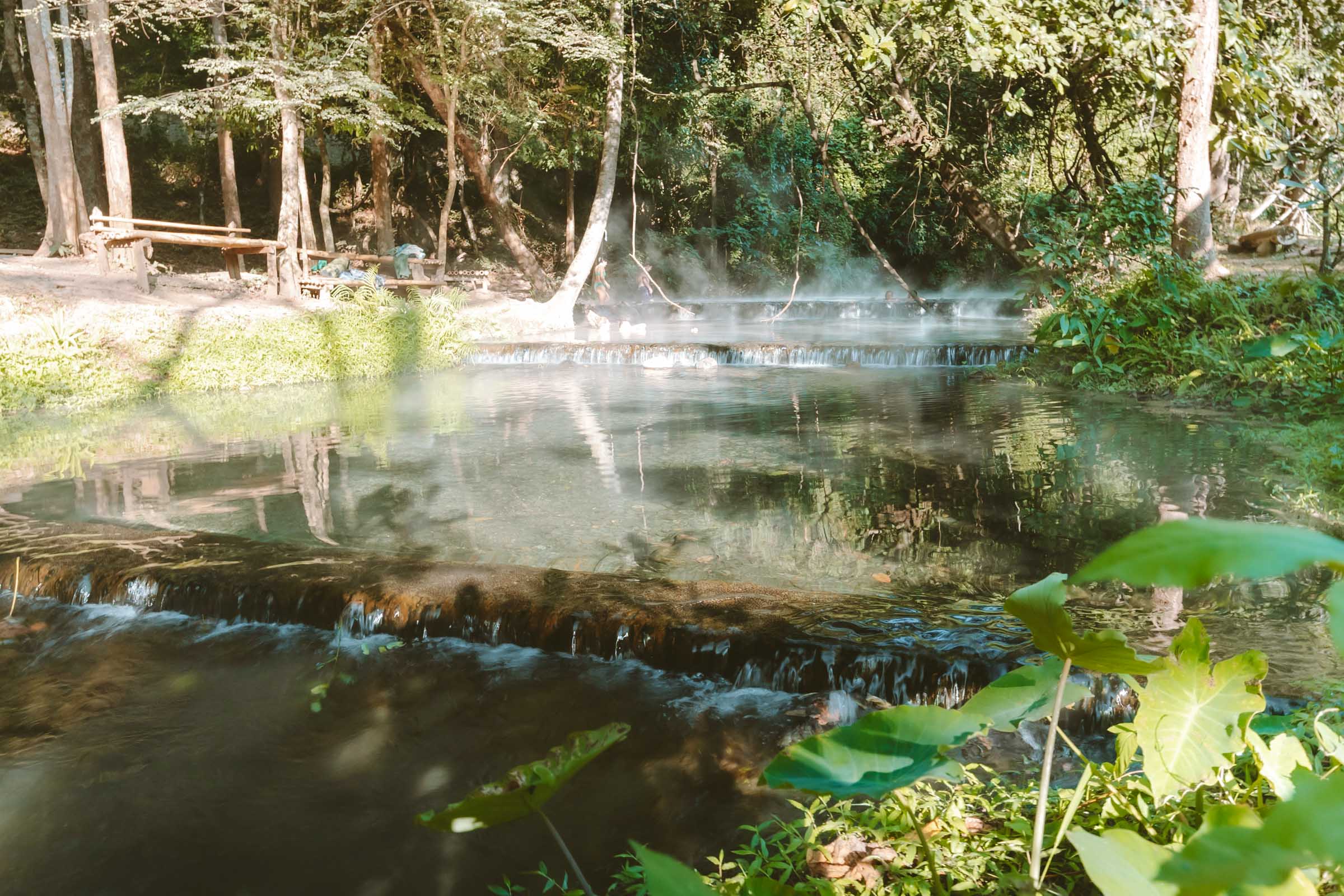
Kho Ku So Bamboo Bridge
The Kho Ku So Bamboo Bridge has an interesting origin. It began as a practical fix for locals to get around their rice fields without damaging the crops. So instead of carving out dirt paths or building roads, they wove together long stretches of bamboo to create bridges that literally go right over the rice fields.
But what started out as a functional way to get around the rice fields eventually became a tourist spot. As Pai became a backpacker destination, travelers started hearing about the bamboo bridges in Pai, and the bridge evolved into a photogenic sightseeing area just outside the town.
The Pai Bamboo Bridge winds through rice fields and grazing pastures. It’s a view of rural Pai, with a few huts where you can sit and relax, along the way. It’s quiet, calm, and more of a slow wander than a major sightseeing stop.
While we were at the Pai Bamboo Bridge, we met a friendly monk who was visiting from Bangkok. He told us he’s working with local farmers to grow a special kind of rice called rainbow rice.
We actually spotted some rainbow rice near the entrance of the bamboo bridge. Its bright color was unmistakable in the dry season. Since this type of rice grows year-round, maybe when you visit the bamboo bridge, the rice fields will be colorful hues of pink and purple.
Read our full blog post: Kho Ku So Bamboo Bridge in Pai: Complete Guide

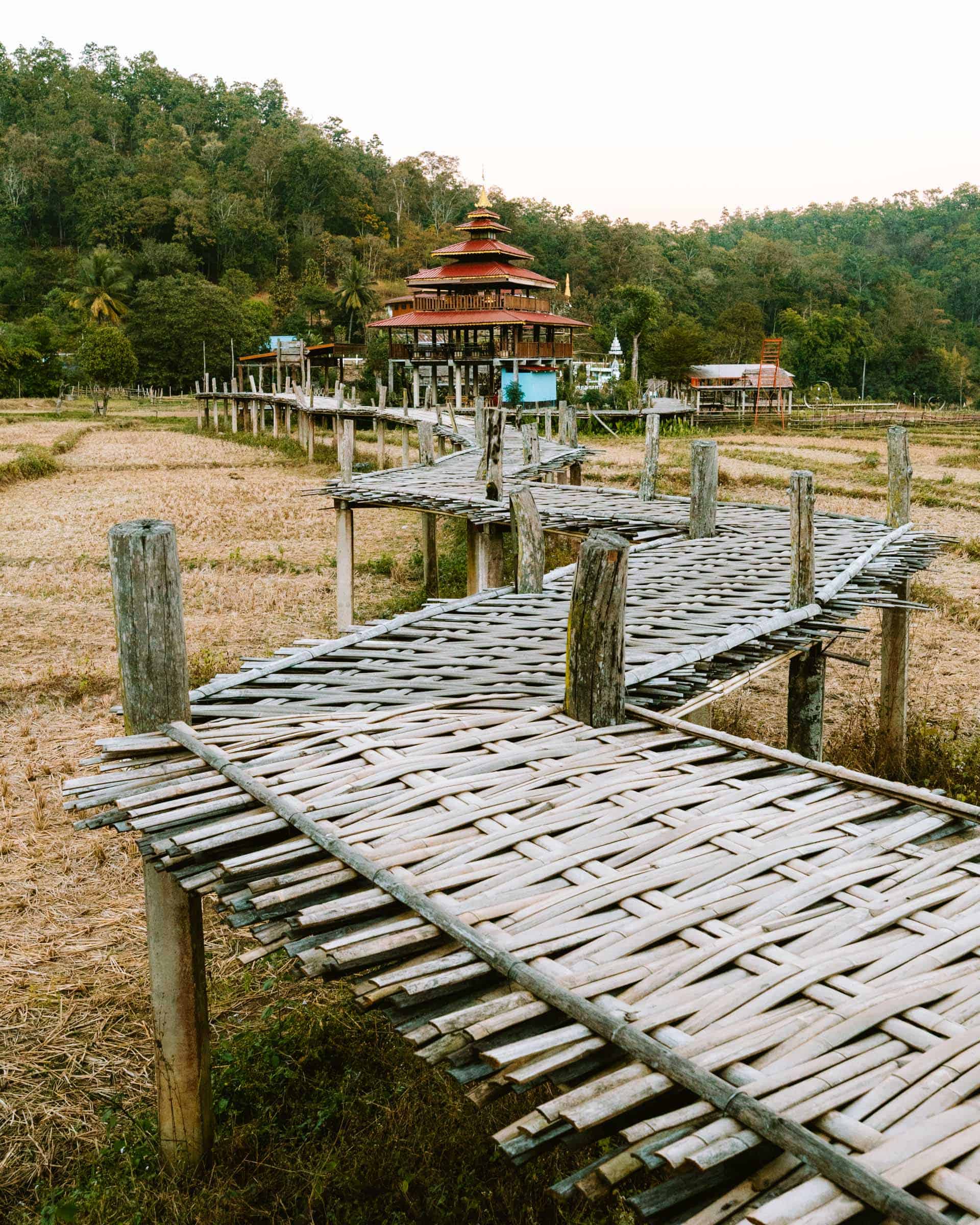

Our Free Pai Google Maps Locations
Do you need a handy map with all our Pai locations? We’ve got a Google Map with all the Pai locations in this post (plus a LOT more). Sign up in the box below and we’ll deliver it right to your inbox, plus our top tips to help you plan your Pai adventure.
Big White Buddha (Chedi Phra That Mae Yen)
The Big White Buddha is one of the most recognizable landmarks in Pai. It’s part of Wat Phra That Mae Yen, a hillside temple that looks out over the Pai valley.
The Buddha sits at the top of a long white staircase. There are about 350 steps from the parking area to the Buddha, and the climb takes about 10 minutes.
But the Big White Buddha in Pai is a little more serious in a way the rest of Pai isn’t. You won’t hear music up there. It’s the kind of place where people take a moment to reflect.
The best time to visit the Big Buddha is in the early morning when the weather is cooler. On some mornings, the Pai valley becomes blanketed with fog, so the Big Buddha rises above the sea of clouds.
We visited the Big Buddha in the middle of the day. It was hot but still worth it.
Read our full blog post: Big White Buddha in Pai: Complete Guide
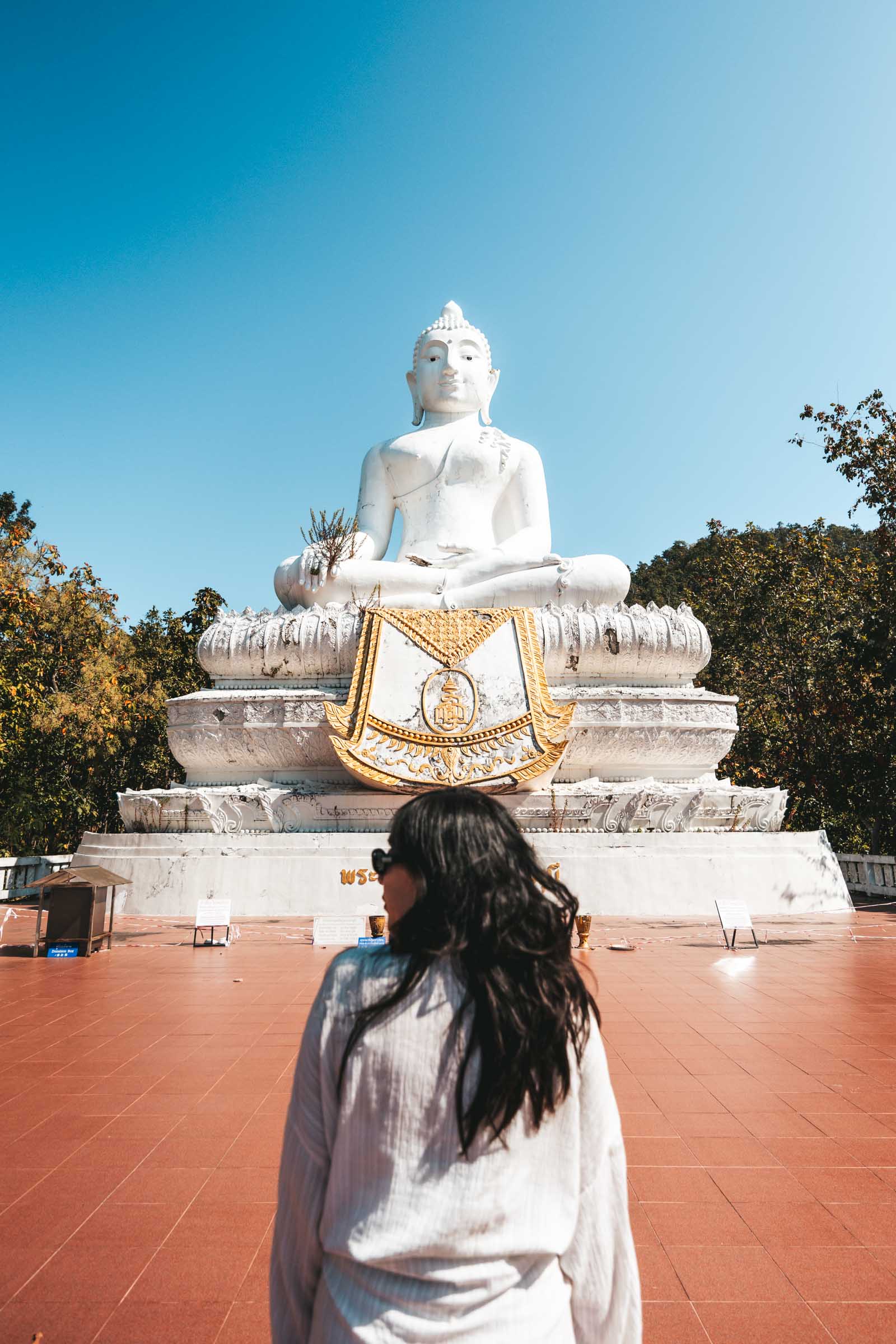


Our Free Pai Google Maps Locations
Do you need a handy map with all our Pai locations? We’ve got a Google Map with all the Pai locations in this post (plus a LOT more). Sign up in the box below and we’ll deliver it right to your inbox, plus our top tips to help you plan your Pai adventure.
Wat Sri Don Chai Temple
Wat Sri Don Chai Temple is considered to be the first temple in Pai. Its often overlooked by most tourists, but in my opinion its the most interesting temple in Pai.
The temple itself is beautiful. Its exterior is lined with gold trim, but I took a long moment to look at the mural on the back of the building. It’s set against a backdrop of palm trees, creating a scene that embodies the essence of a tropical temple.
This 700-year-old temple has a blend of Burmese and Lanna architectural styles, and the temple grounds have plenty of shade so you can escape the sun on hot days.
You can also make a donation to receive a temple offering that’s based on your zodiac sign. And if you’re looking for another fun activity, you can buy fish food to feed the fish in the large pond on the property.
The monks here are incredibly friendly and approachable. During one of our visits, we had the opportunity to chat with a monk, and he was extremely welcoming and happy that we came to visit his temple.
Read our full blog post: Wat Sri Don Chai Temple in Pai: Complete Guide

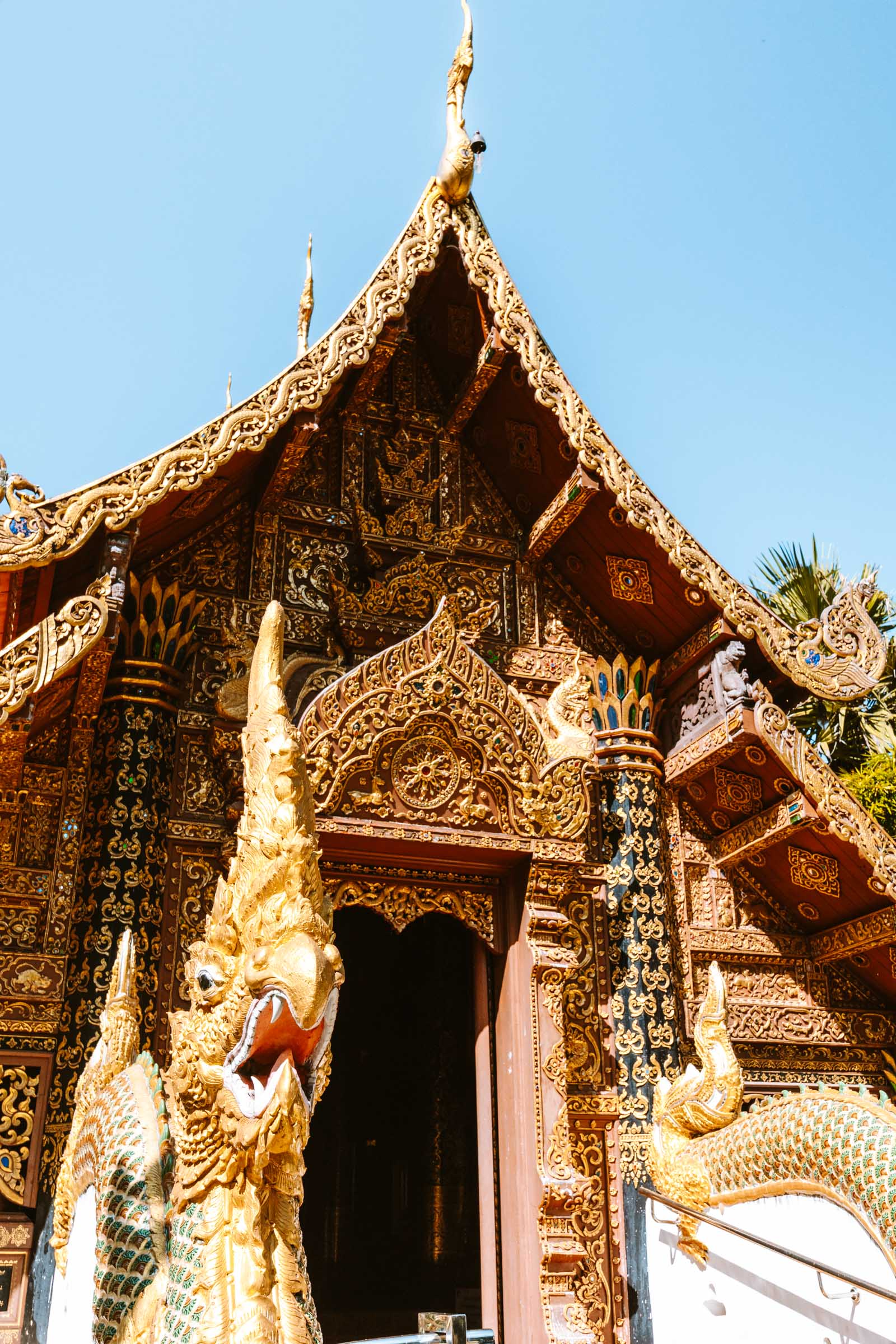

Wat Sai Khao
Wat Sai Khao is another small temple in Pai. It’s located in the middle of the rice fields, and it stands out from the area with its blue color and gold trim.
The temple’s entrance is something you won’t forget. The staircase is lined with seven-headed gold serpents with large sharp teeth. For some reason, they are both scary and inviting at the same time, if that’s even possible.
During our visit, the temple was full of monks performing a ceremony. We decided not to intrude upon them, so we didn’t get to see the interior of the temple. But it did provide us with a memorable moment since we were able to witness the temple in action.
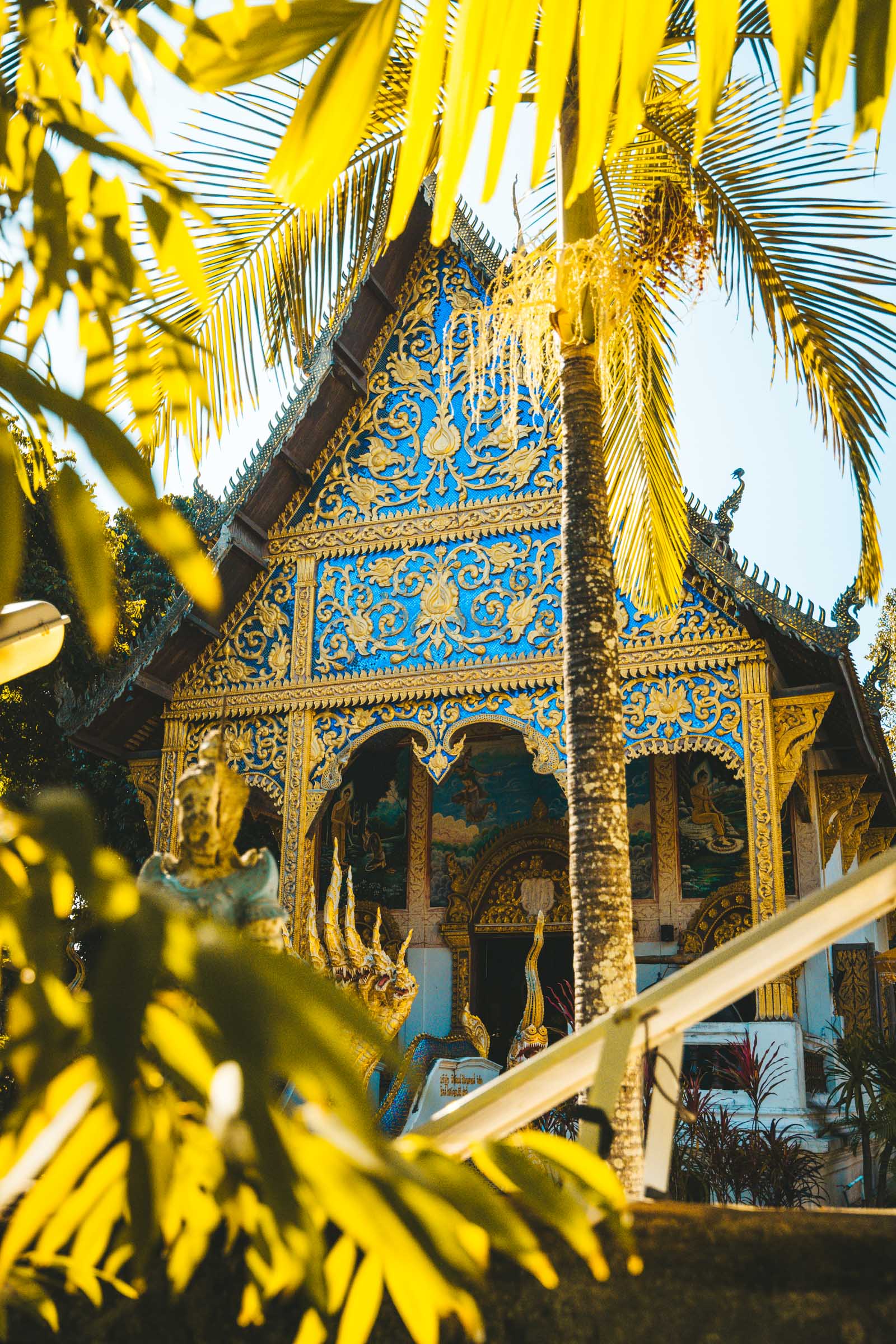

Pai Night Market
A visit to Pai isn’t complete without experiencing its night market. Every evening, the streets close off to car traffic, transforming the Pai Night Market into a lively pedestrian zone.
The atmosphere is filled with a mix of tourists, locals, vendors, and an array of smells and sounds.
The market is essentially divided into two main sections—
On one side, you’ll find stalls selling clothes, souvenirs, and trinkets.
On the other side, you’ll find an array of street food stalls. As you venture further down the food street, the market transitions into a more festive atmosphere, where you can find bars serving alcohol and herbs.
We spent nearly every evening at the Pai Night Market, since its a great place to just grab a quick bite to eat before perusing the market for some shopping. It’s a place where Pai’s laid-back yet energetic culture comes to life.
- Pai Night Market Hours: 6:00 PM – 10:00 PM

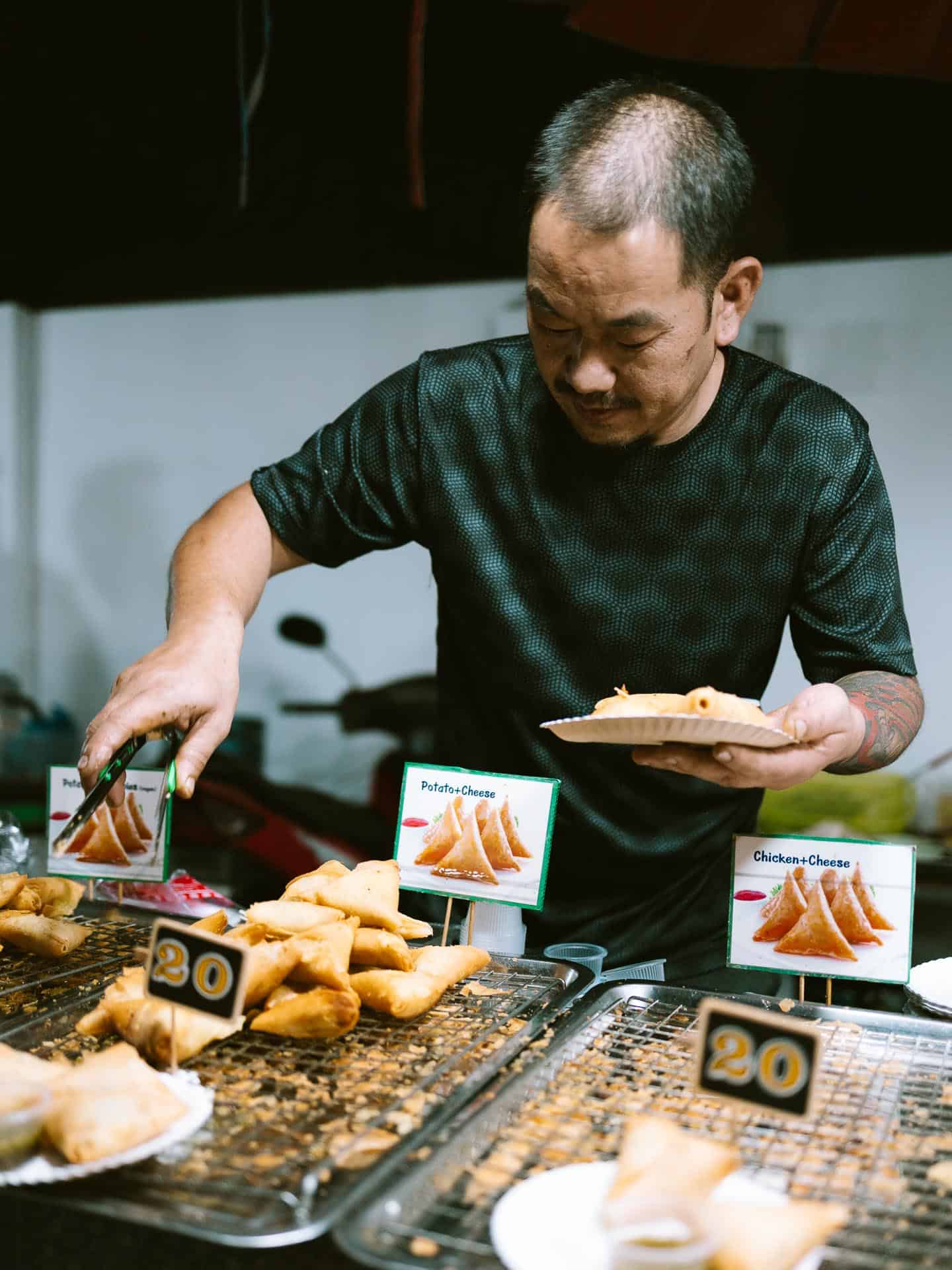

Explore Pai’s Backroads
Exploring Pai’s backroads on a motorbike turned out to be more than mode of transportation for us. It was an adventure in itself, and easily one of our favorite activities in Pai.
We loved getting lost on the country roads in Pai and made a point to do it every day. From encountering adorable water buffaloes to stumbling upon secret local swimming spots in the river and even finding lesser-known places to watch the sunset, a motorbike allowed us to experience Pai in a unique way that you can’t otherwise.
For about 150 to 300 baht per day, you can rent a motorbike to get around Pai and ramble all over the backroads. Who knows, maybe you might find some secret spots of your own.
When renting a motorbike in Thailand, you need to leave some form of collateral. This is usually either your passport or a cash deposit of around 2000-3000 baht.

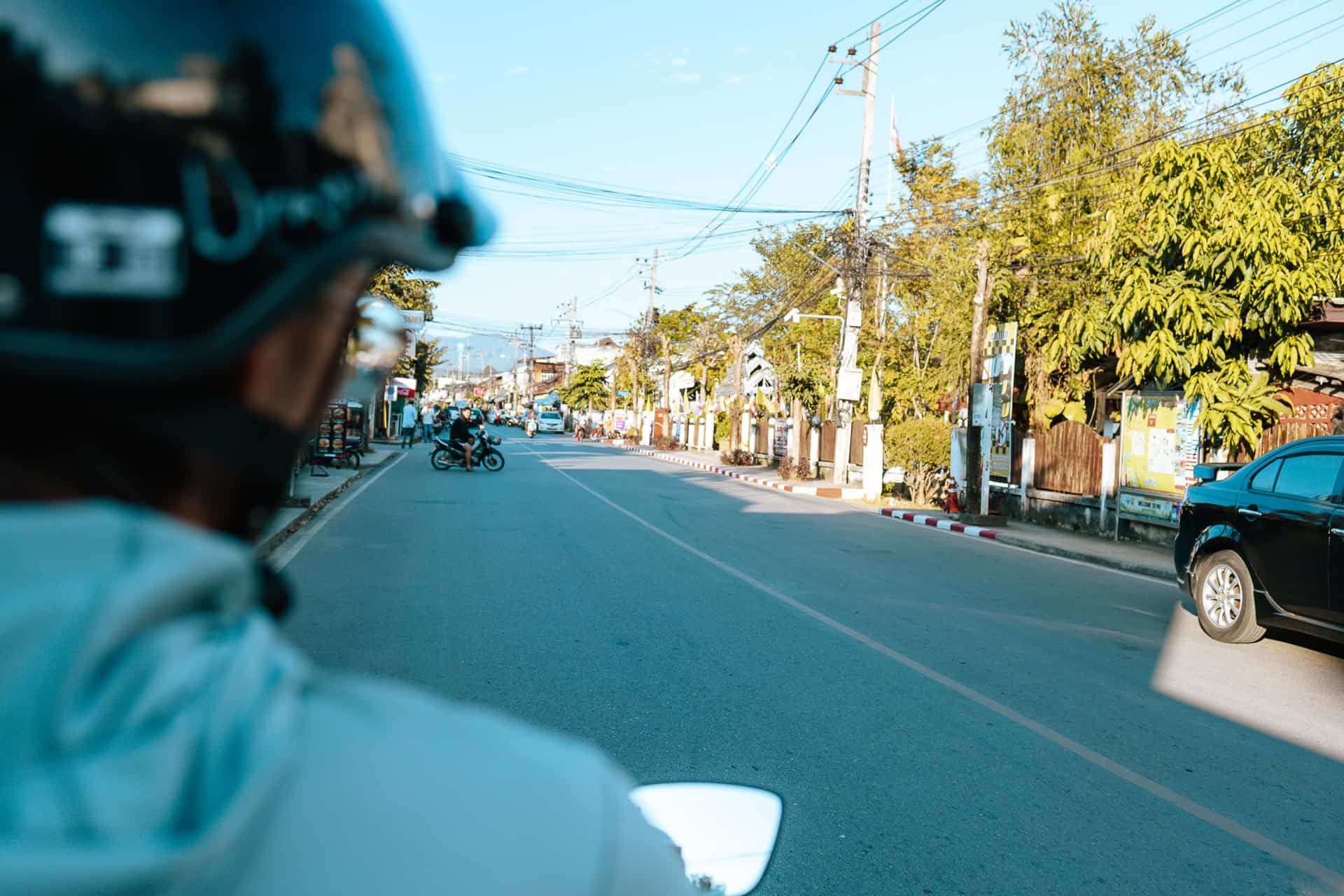

Bamboo Bridge
Unlike the Kho Ku So Bamboo Bridge, this bamboo bridge is less scenic and more utilitarian. It serves as a handy way to get across the Pai River, and you’ll see plenty of locals motorbiking across the bridge while out on their daily activities.
You can use the bridge yourself, as we did when driving back from Pai Canyon to Pai on the backroads.

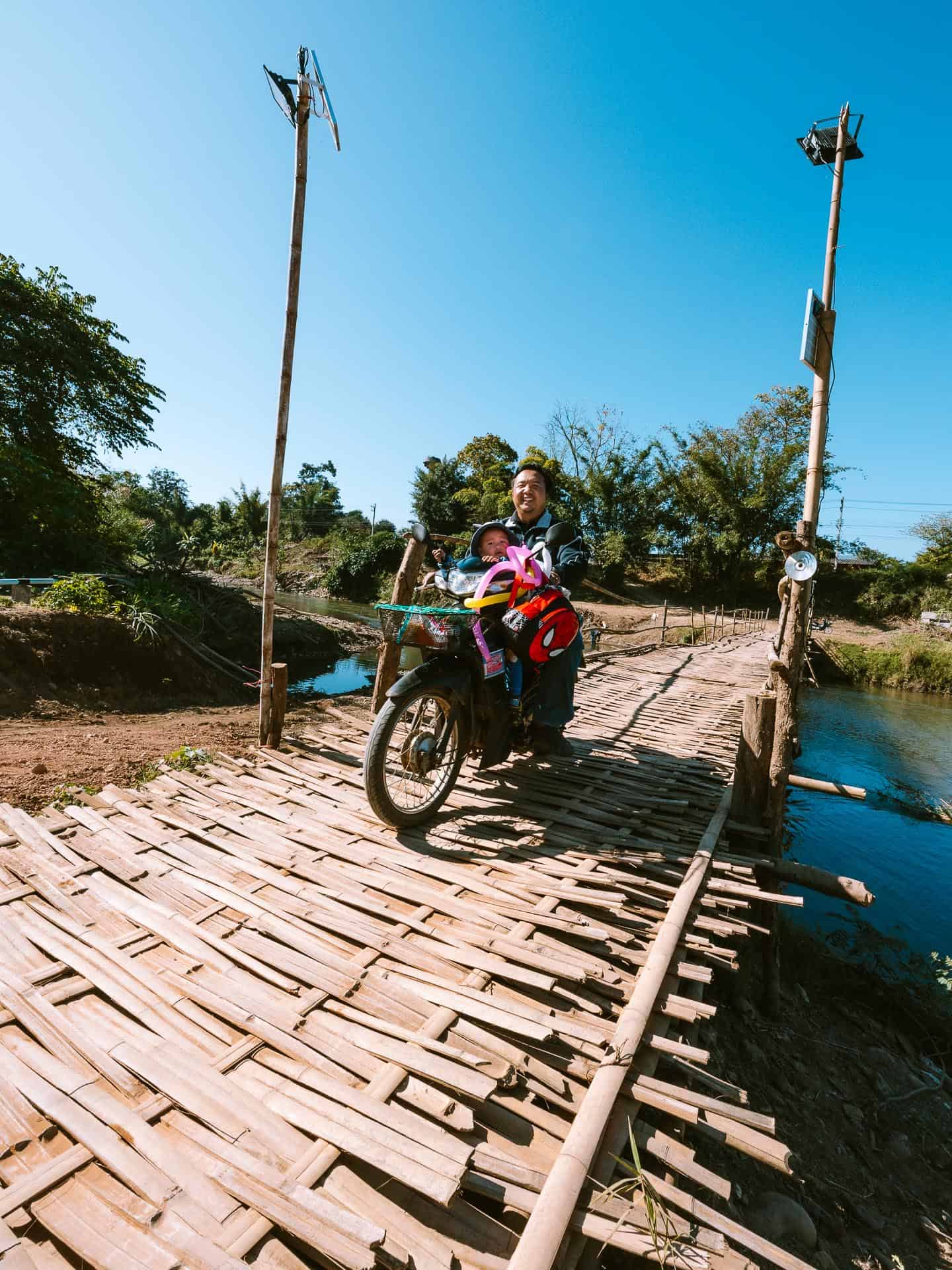
Tha Pai Memorial Bridge
One of our unplanned discoveries while exploring Pai on our motorbike was the Tha Pai Memorial Bridge.
The bridge has an interesting story. It was originally built by the Japanese to facilitate better access routes during World War 2, but was dismantled after the war ended. However, the local community rebuilt the bridge since it was an important route to get across the Pai River.
Today, the bridge is no longer in use and a new one has taken its place for traffic purposes. However, the old bridge still exists as a historical point of interest.
When we visited the bridge, we were surprised to find that much of its old wooden baseboards remained, some even showing signs of rot. Despite being safe, there’s an element of thrill due to its slightly sketchy nature.
There are also street vendors on both sides of the bridge entrances if you’re looking to get a quick snack.
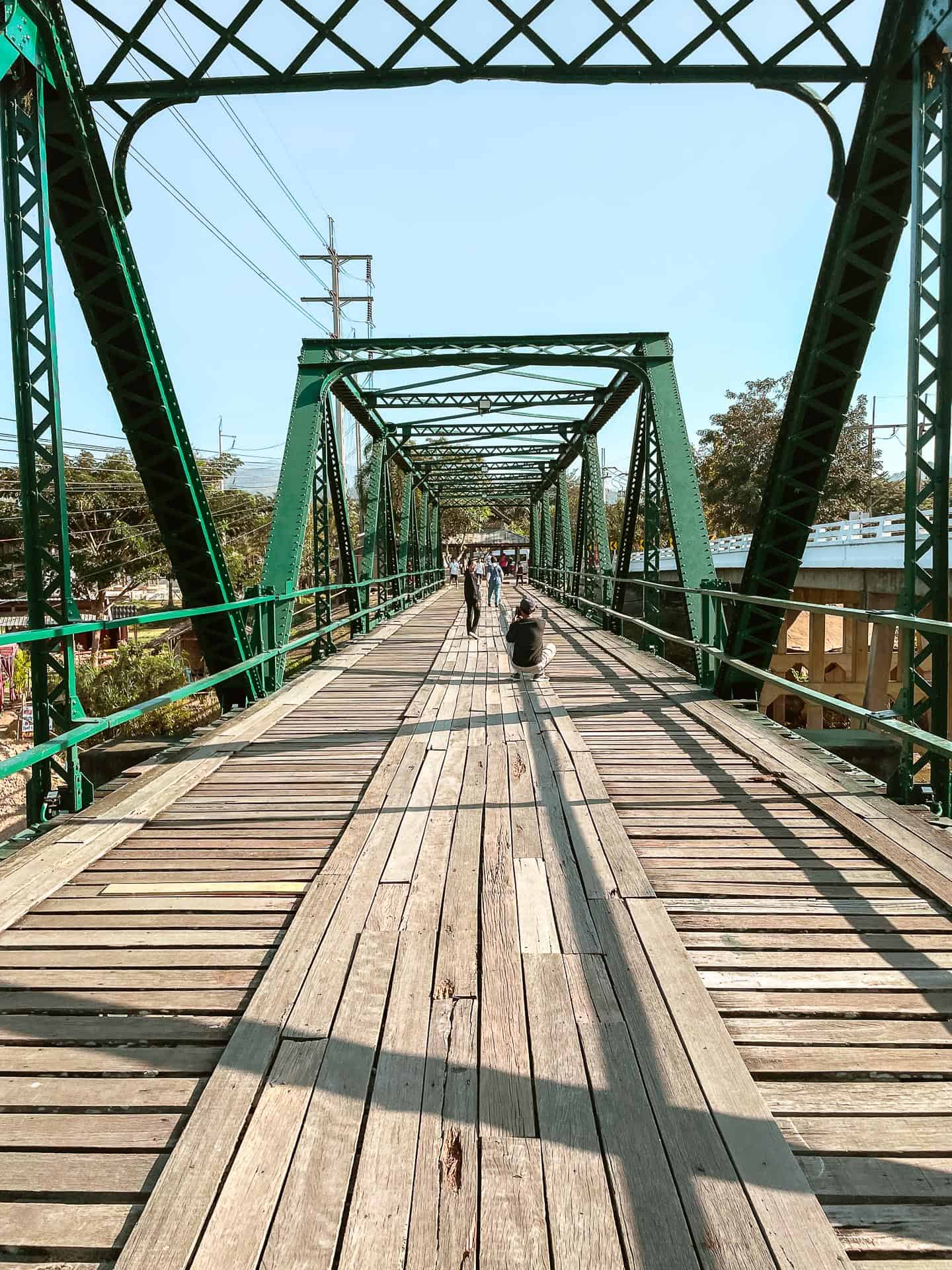
Mo Paeng Waterfall
During one of our motorbike explorations around Pai, we stumbled upon Mo Paeng Waterfall.
It’s a multi-tiered waterfall and an ideal spot for hang out and go for a swim with some friends. The place is pretty built out and has well-developed trailways.
Remember when I said we stumbled upon this place? We messed up by not planning ahead and bringing our swimsuits. It was incredibly tempting to take a swim. We will definitely be back next time!

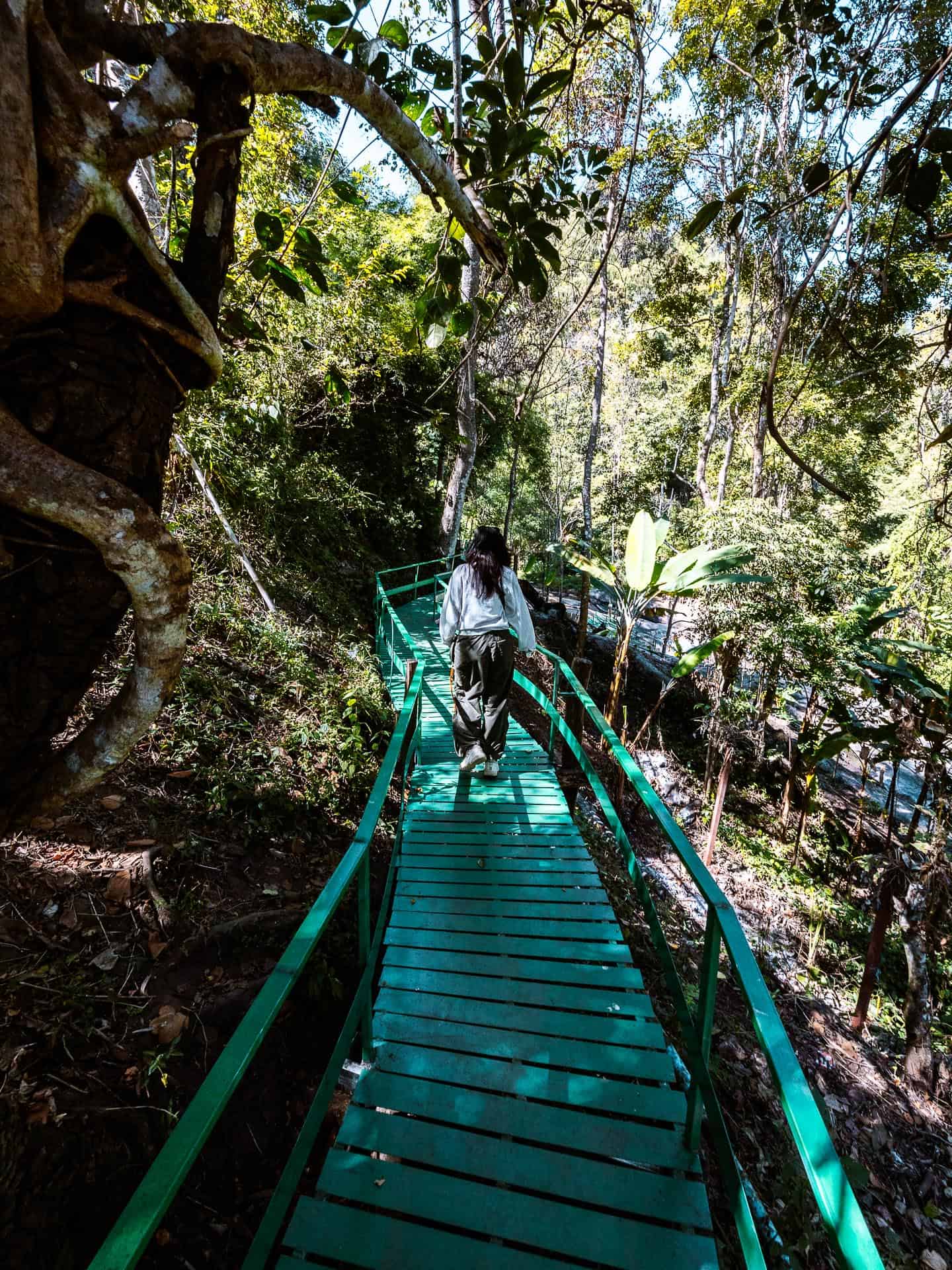

Santichon Chinese Village
Santichon Village is a place that surprised us. It’s a cultural village built and run by the very community it represents, the ethnic Yunnanese Chinese who settled in Pai decades ago. That might not sound unusual at first, but in a world full of staged cultural experiences designed by outsiders, this place is a little different.
While the village is definitely set up for tourism, it’s still run by the local community. You’ll find clay-walled houses, Yunnanese tea shops, and souvenir stands.
The village also has a few activities you can take part in, such as archery, dressing up in traditional costumes, and riding their unique wooden swing that spins in circles.
Our first stop was what I like to call marksman training. But in reality, it was just shooting a few arrows at a straw target. It looked pretty easy until I tried it. Once I shot the bow, I realized how tricky it was. I’ve shot arrows before, but I was pretty rusty. Just getting anywhere on the target felt like a win.
But our real highlight of visiting the village was the wooden swing. It was unlike any other swing in that it didn’t go back and forth. Rather, it went around in circles. More like a mini Ferris wheel!
Read our full blog post: Santichon Village in Pai: Complete Guide

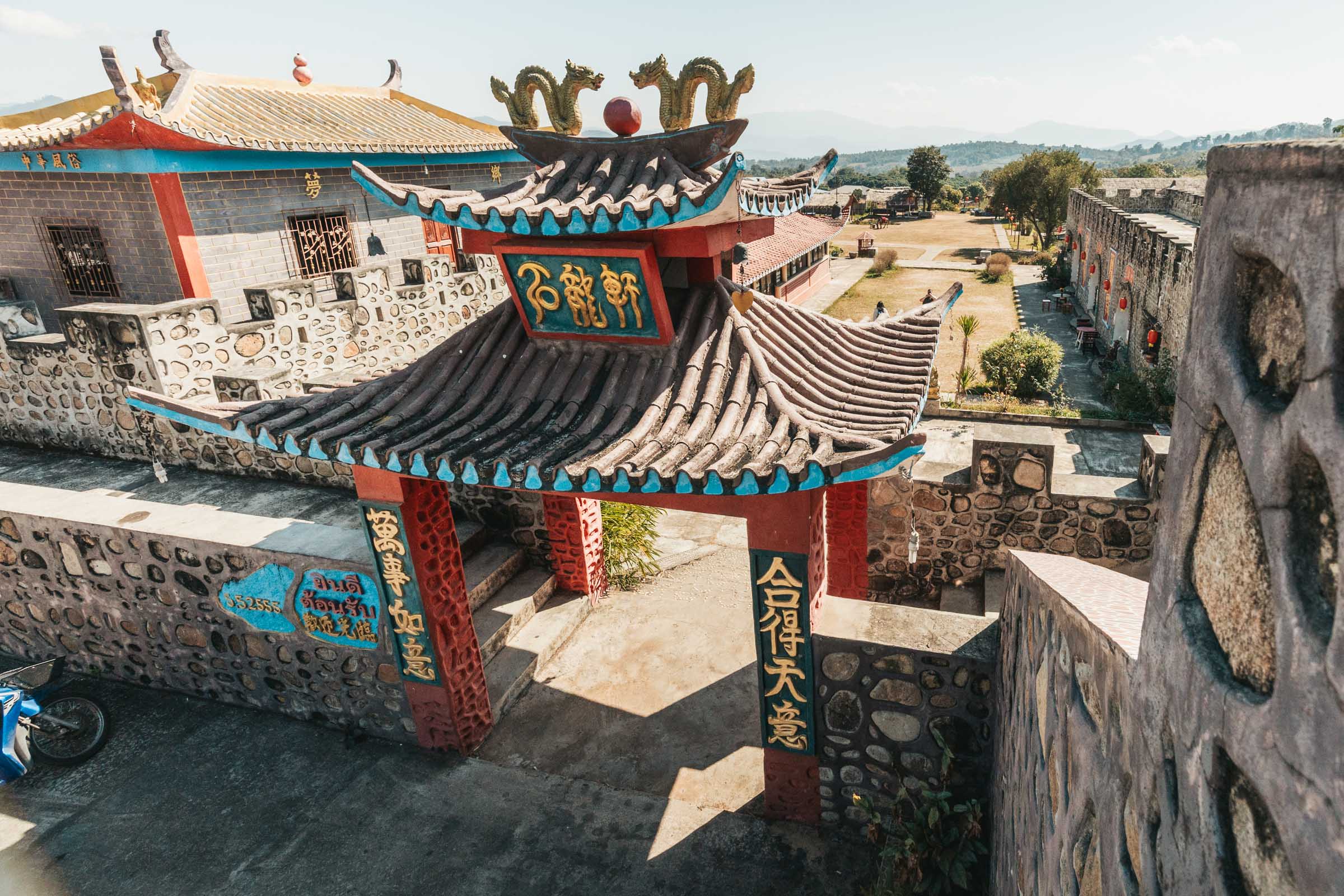

Yun Lai Viewpoint
Pai has no shortage of scenic spots, but Yun Lai Viewpoint is easily the most famous. It sits in the hills above Pai and has a wide expansive view. It’s a super popular spot for sunrise, where you can watch the sun peek over the mountains in the distance while fog looms inside the valley below.
The viewpoint itself is built up. It has a small cafe where you can grab a cold drink. It also has a tree decorated with hanging heart-shaped tokens if you want to leave a romantic note behind.
There are also basic camping facilities on-site if you want to stay overnight and catch sunrise without riding out there early morning in the dark.
But what stood out more to us wasn’t the viewpoint itself, but the area around it. The backroads leading up to Yun Lai go through quiet farmland and villages. You get to see a quieter side of Pai that many people overlook.
Read our full blog post: Yun Lai Viewpoint in Pai: Complete Guide

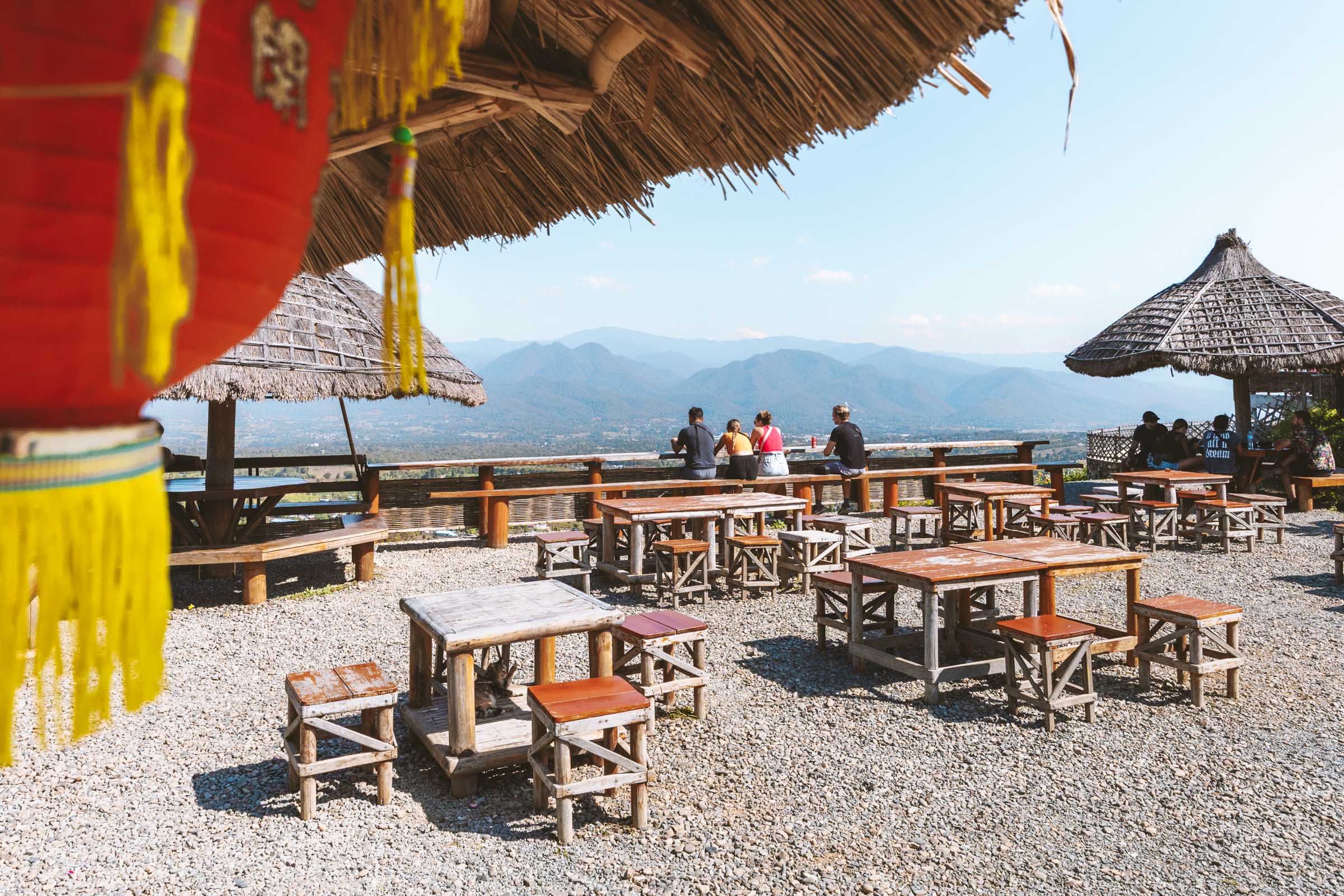
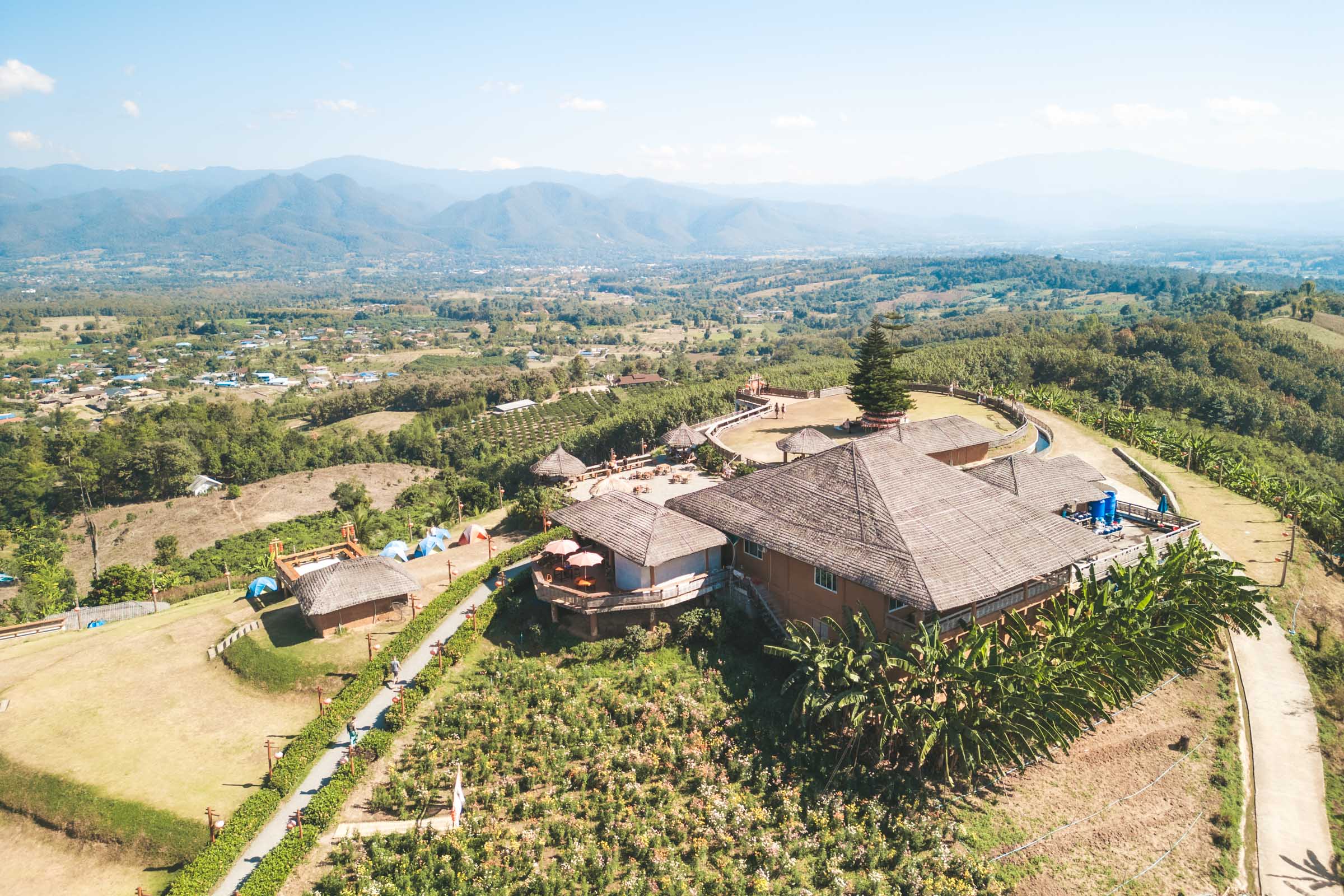
Two Huts Pai
Two Huts is a charming cafe nestled on the “backroad” route to Tha Pai Memorial Bridge. The cafe has some of the best panoramic views of Pai’s mountains and valleys. It has rightfully earned its reputation as one of the best spots for watching sunsets in Pai, right up there next to Pai Canyon.
Two Huts sells a variety of beverages and serves food, making it an awesome spot for an evening meal or a relaxing drink. Due to its popularity, especially around sunset, it’s best to get there early if you want to secure a prime spot with the best views.
- Hours: 10 AM – 9 PM
- Location: 📍 Two Huts Pai – Google Maps
Where to Eat in Pai
There is no shortage of delicious food in Pai. During our travels through Asia, I haven’t found a place where I was genuinely looking forward to every single meal… until I went to Pai.
What makes Pai’s food scene wonderful is its combination of affordability and quality. If you are on a budget, I recommend eating at the local Thai restaurants, where we never spent more than 130 baht for the two of us!
Besides local Thai food, Pai is also a vegan’s dream destination. The vegan meals here are so delicious that I made it a point to start each day with a vegan breakfast. It was a healthy start to every day.
To help you navigate Pai’s food scene, here are some restaurants we personally visited and recommend:
- Nong Nung (Thai food)
- Thai Kitchen (Thai food)
- Racha Noodle & Gravy (Thai food)
- Nong Beer Restaurant (Thai food)
- Fat Cat (Vegan options)
- Earth Tone (Vegan Options)
- Free Bird Cafe (Vegan)
- Lemon Thyme Cafe (Vegan options)
- Ganita Cafe (Chicken Sandwich)
- Pulut Ayam Goreng Halal Pai (Takeout fried chicken frequented by locals – one of the best we’ve ever had!)
- Dammie Cafe (Chill brunch atmosphere)
- Tham Ma Daa Cafe (Chill atmosphere with a pond)
- Street Food @ Pai Night Market
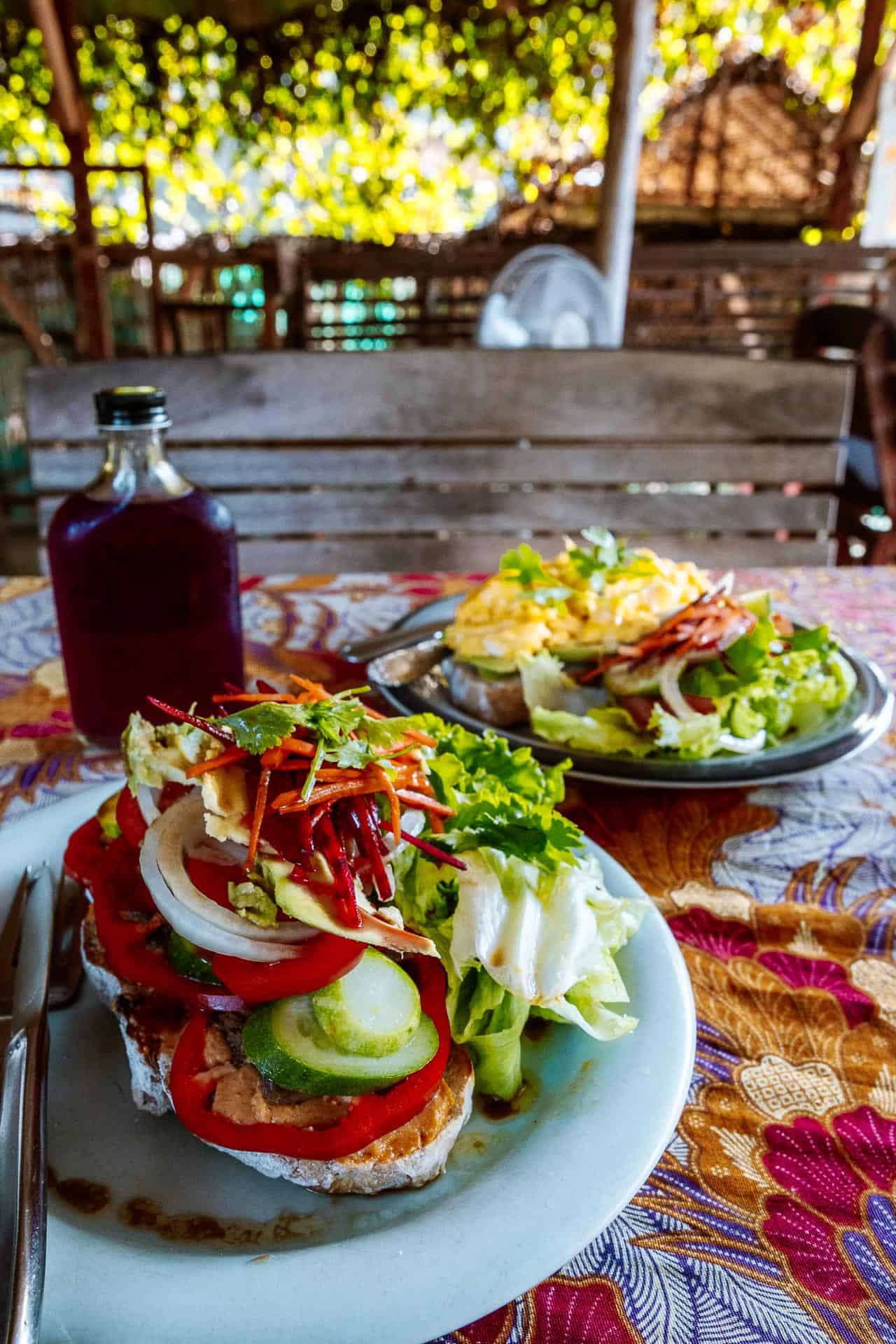


Where to Stay in Pai
Wiang Tai (Central Pai) is the heart of Pai and where most of the town’s accommodations are located. It’s where you’ll find Pai’s walking street, night market, cafes, bars, restaurants, scooter rentals, shops, and pretty much everything you’ll need for your stay. It is the easiest place to base yourself if you want to be in the center of the action and Pai’s social scene.
Here are our recommendations on where to stay in Wiang Tai:
If you’re looking for a more rural area with a free-spirited vibe, then Mae Hai is a better fit. It’s a big area that’s adjacent to Central Pai. Some parts of it sit deep in the countryside amongst rice fields, country roads, and wide open views.
Here are our recommendations on where to stay in Mae Hai:
If you prefer to find your own place to stay, you can visit Booking.com to explore all your accommodation options in Pai.
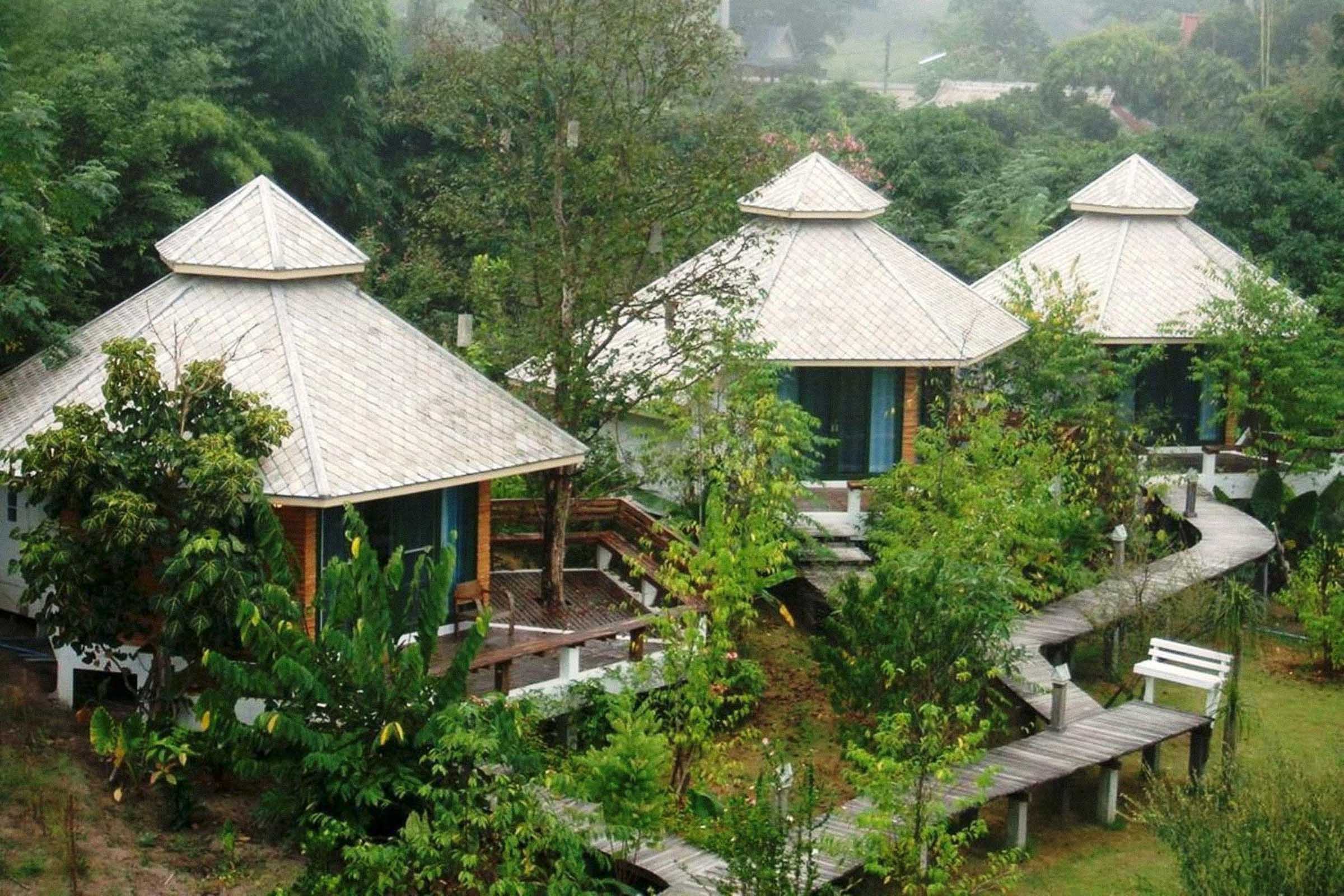

Our Free Pai Google Maps Locations
Want a free map of all of the locations mentioned in this post? Sign up in the box below and we’ll deliver one right to your inbox, plus our top tips to help you plan your Pai trip!
How to Get to Pai
Getting to Pai is relatively straightforward, as multiple methods of transportation suit different budgets, time constraints, and travel styles.
Here are some of the most common ways to get to Pai:
Pai Day Trip from Chiang Mai
If you are based in Chiang Mai you can check out the top-rated Pai Highlights Private One Day Trip, which includes transportation and a guide to Pai.

Shuttle Bus/Van
In my opinion, the best method for traveling from Chiang Mai to Pai is booking a van with 12Go. That’s is how we got to Pai.
The van we rode sat about 9 passengers. It was a fun experience since we chatted with a few other travelers during the ride. At the halfway point, the van stopped for a 15-minute bathroom break.
If you’re prone to motion sickness, I recommend taking motion sickness medication when you get in the van since the roads are very winding.
My best tip is to avoid being the last to board. The last to board gets the last seat choice — usually in the rear. The rear seats are cramped and most people get motion sick back there.
We were fortunate to get seats in the front of the bus, but the others in the back were complaining about motion sickness.
Once you get to Pai, the van drops you off on Pai Walking Street. From there, you may need to walk or find another transport to your accommodation.
Songthaews are readily available right at the van drop-off point, so if you’re staying further out, you can hop in a songthaew to get to your final destination.
Motorbike
If you’re adventurous and skilled at riding a motorbike, riding all the way from Chiang Mai is a popular way to get to Pai.
The ride takes approximately 3 hours, and traverses over winding mountain roads. The roads are wide and well-paved but they are also dangerous because of speeding cars, vans and cargo trucks. And its even worse if its been raining.
I don’t recommend this route unless you have lots of motorbike riding experience.
How To Get Around Pai
The best way to get around Pai is by motorbike. There are a bunch of motorbike rental vendors in Pai. Motorbike rentals in Pai typically start at around 150 baht per day.
Keep in mind that when renting a motorbike in Pai (or anywhere in Thailand), you usually need to leave some form of collateral. Typically, either your passport or a cash deposit of around 2000-3000 baht.
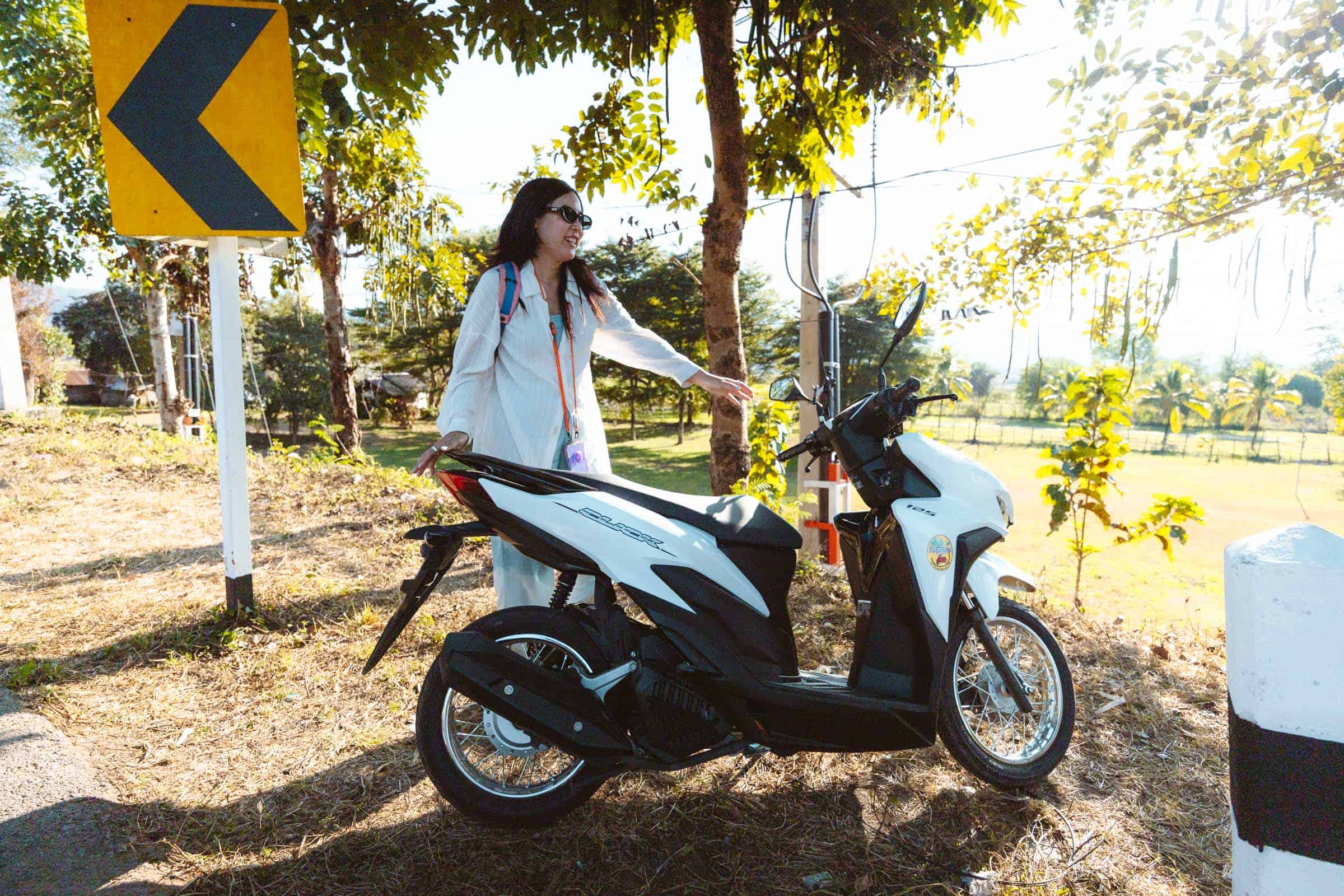
If you’re not comfortable riding a motorbike, you can also get around Pai by hiring a songthaew. Songthaews go too all the most popular spots, but you’ll need to share it with others as it is a shared taxi service.
You can even hire a songthaew for a tour around Pai if you want to go sightseeing. Just be sure to negotiate the rate before starting your ride.
Are You Following Our Pai Blog Series?
We spent 7 days in Pai and found so many things to do there… from canyons to mountains, waterfalls, and hot springs. To help fellow adventurers, we’ve put together guides to the best places we found. You can check them out by clicking the links below.
- Start planning your trip here: Pai Travel Guide
- Our ultimate guide to Pai: 14 Incredible Things to Do in Pai
- Our Pai accommodation guide: Where to Stay in Pai
- Best place to wander around in Pai: Kho Ku So Bamboo Bridge
- Our favorite place to swim in Pai: Sai Ngam Hot Spring
- Best sunrise views in Pai: Yun Lai Viewpoint
- Our favorite temple in Pai: Wat Sri Don Chai
- Best sunset in Pai: Pai Canyon
- Pai’s Chinese Cultural Village: Santichon Village

I hope my guide to things to do in Pai helped you plan your adventure there. Leave a comment below if you have any questions! 🐸

